
Science fiction and technology writer
Popular blog posts
Recent forum posts
Discussion Forum
Discussion forumDouglas Adams predicted the end of cryptocurrency, 42 years ago
Post #: 290
Post type: Blog post
Date: 2022-05-20 18:05:15.000
Author: Jeremy Reimer
Tags:

In 1980, Douglas Adams wrote The Restaurant at the End of the Universe. In this excerpt, Ford and Arthur have time-traveled back to prehistoric Earth, which has just been invaded by a colony ship comprised entirely of people with useless jobs.
“How can you have money,” demanded Ford, “if none of you actually produces anything? It doesn't grow on trees you know.”
“If you would allow me to continue.. .”
Ford nodded dejectedly.
“Thank you. Since we decided a few weeks ago to adopt the leaf as legal tender, we have, of course, all become immensely rich.”
Ford stared in disbelief at the crowd who were murmuring appreciatively at this and greedily fingering the wads of leaves with which their track suits were stuffed.
“But we have also,” continued the management consultant, “run into a small inflation problem on account of the high level of leaf availability, which means that, I gather, the current going rate has something like three deciduous forests buying one ship’s peanut."
Murmurs of alarm came from the crowd. The management consultant waved them down.
“So in order to obviate this problem,” he continued, “and effectively revalue the leaf, we are about to embark on a massive defoliation campaign, and. . .er, burn down all the forests. I think you'll all agree that's a sensible move under the circumstances."
Last week, a crypto coin called Luna collapsed, from a high of $110 per coin to $0 today. Actually it was two crypto coins--the other one was called Terra--and the two were linked together to try and make Terra a “stablecoin” that would have its value constantly pegged to exactly one US dollar. Terra collapsed at the same time, and this made the price of Luna go down even more, starting a death spiral. Billions of dollars vanished in the space of a couple of days. There are many stories of small investors losing their entire life savings.
Crypto currencies have no inherent use, as you can’t typically pay for things with them, and you can’t pay your taxes with them. However, people have valued useless things many times in the past. From Dutch tulip bulbs to Beanie Babies to NFTs, people can get always hyped up about investing in things with no purpose, as long as they think the thing will increase in value.
In the case of Luna and Terra, the main reason people started to value them was because the company that created both was offering a 20% income return for anyone who stored Terra on their servers. Ostensibly, this was so the company could “loan” the coin to others.
Charles Ponzi offered investors a 50% return in the early 1920s, and his scheme lasted a couple of years before it all fell apart. Terra and Luna didn’t quite make it that long.
Before it collapsed, Luna and Terra were considered darlings of the cryptocurrency industry, creating a new “platform” for the “future of finance”. Now, they are dismissed as merely a scam, even by cryptocurrency enthusiasts. But if one “stablecoin” was always a house of cards, why not the others?
The poor folks holding Luna today have been wiped out, and they are struggling to come to terms with it. Many still believe that there is something that can be done to restore Luna’s valuation. And in a discussion thread about what should be done next, I found this tweet:
Just burn it all down. That will create value. Just like it did with the forests.
Views: 3650
A logo for micro-history.com
Post #: 289
Post type: Blog post
Date: 2022-04-20 20:16:36.000
Author: Jeremy Reimer
Tags: Computers Microhistory

This is a little something I whipped up on paper and then made real with a great little program called Affinity Designer.
I started with a stylized representation of an old 1970s all-in-one computer, something like a TRS-80 Model III, or my own Heathkit H-89.
Then I replaced the floppy disk drive on the right with a stylized book, to indicate the "history" portion of the site. Micro, History? Get it?
The orange color is just a color I liked and decided to theme the site around. No personal computers in the 1970s and 1980s were orange, but maybe that's the point. I tried the logo in more boring colors like grey and beige, but it just wasn't as cool.
And cool was what I was going for.
Views: 3027
The case for preserving microcomputer history
Post #: 288
Post type: Blog post
Date: 2022-03-31 15:15:42.000
Author: Jeremy Reimer
Tags: Computers Microhistory
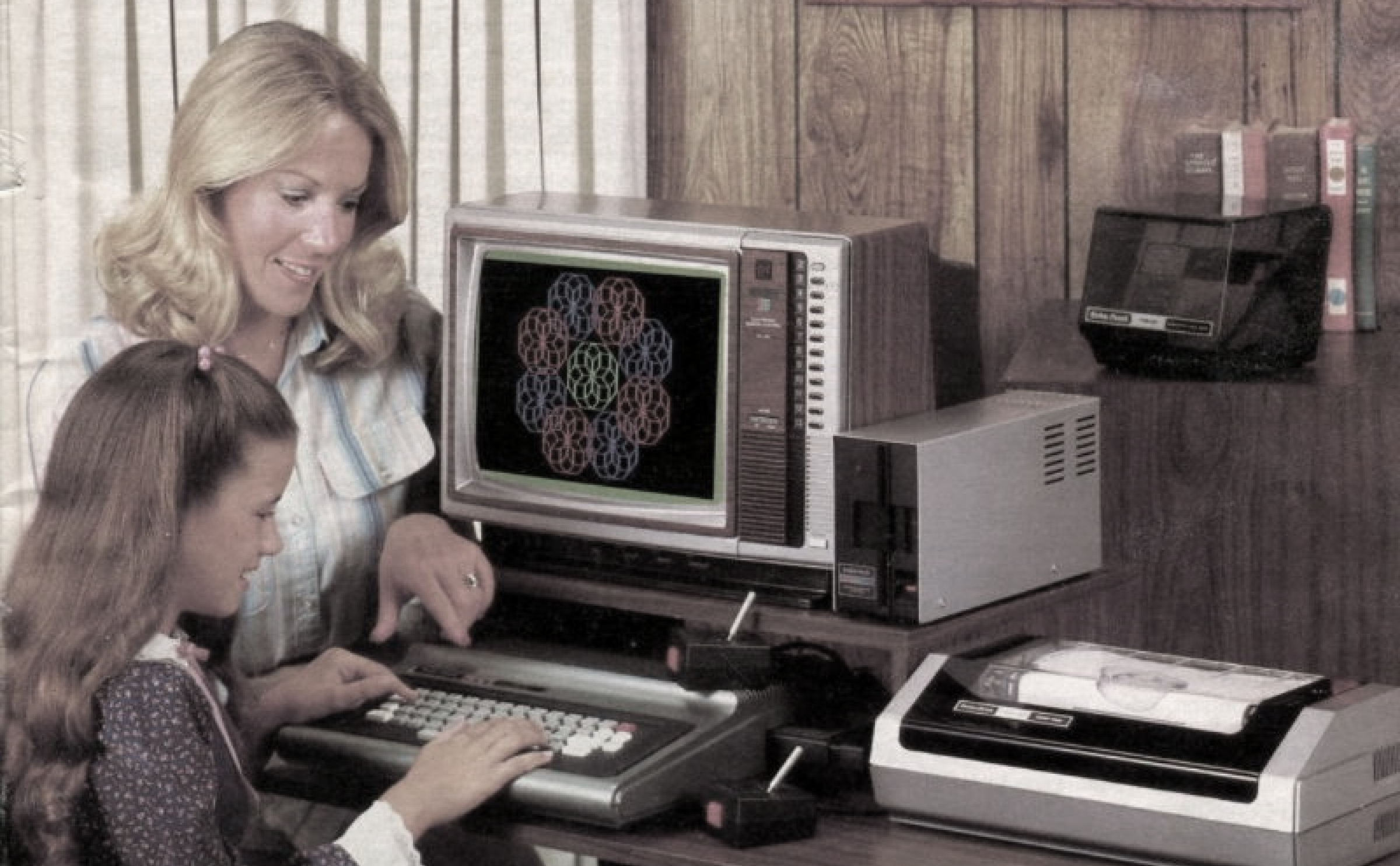
The term “Microcomputer” was born in the 1970s, along with computers it described. It distinguished these machines from “minicomputers”, which were the size of refrigerators, and “mainframes”, which were the size of rooms. Sometimes entire floors.
But while minicomputers were just smaller mainframes, microcomputers were a completely different thing. Banks and governments used mainframes, as they still do (in some cases) today. Minis were cheaper than mainframes, so they could be used by smaller organizations, like universities. Both types of computers were designed for, and sold to, institutions.
But microcomputers were for people.
The companies that made mainframes and minis couldn’t understand why any individual would want to own a computer. And the folks who made micros happen were people who would do anything to have their own personal computer. So when Steve Wozniak designed the Apple I at his desk at Hewlett-Packard on his own time, for fun, he was required by his contract to offer HP the chance to own it.
The HP manager declined, and the rest was history.
Today, we all carry, at all times, a nanocomputer, a super tiny and powerful computer in our pocket that is entirely ours, and is typically called a “smartphone”. Smartphones aren’t phones at all. They are smaller microcomputers, in exactly the same way that minis were smaller mainframes. They all connect to a massive global network of even more powerful microcomputers that all talk to each other constantly.
How did we get from there to here?
The story of the personal computer, the microcomputer, has been told at various times by various people. Some of these stories are in books that are now out of print and on television shows that can no longer be found on anything but faded, used VHS tapes.
And some of the folks who were around at the beginning of this revolution are starting to pass on. In just the last couple of years, we’ve lost Clive Sinclair, who gave the world the ZX81 and Spectrum, and John Roach, the driving force behind the TRS-80, among others.
There are many stories of this time that remain untold. There weren’t just a couple of microcomputer companies in the late 1970s. There were over fifty.. I know this because I counted them once, as a kid, looking at a single issue of Computers and Electronics. Even back then I knew this number was unsustainable. The industry exploded and companies rose and fell with frightening speed. Many fortunes were made and lost.
So who is going to tell all these stories?
I have my own experience in this space. Thanks to Ars Technica, I was able to complete my own dream of telling the complete History of the Amiga. This took me years, but it was some of the most exciting writing I’ve ever done.
Now, I want to do the same thing, but for all the other computers. I also want to do this on a new website that I’m building myself.
It’s a big project, and I’m going to need a lot of help. It also won’t happen right away. I’m going to take the time to prepare the groundwork first.
If you’d like to know more, and you’d like to sign up to be notified when the alpha of the site goes live, just head over to micro-history.com and sign up.
I’ll see you there!
Views: 3314
Why the Metaverse will never happen (it’s not about the technology)
Post #: 287
Post type: Blog post
Date: 2022-02-16 18:03:38.000
Author: Jeremy Reimer
Tags: gaming metaverse

If you’ve been following technology news over the past six months, you’ve undoubtedly heard the term “Metaverse” being promoted from many sources. Last October, Facebook announced it was changing its name to “Meta”, and Mark Zuckerberg released a video explaining how the company was going to start building “the Metaverse” and how awesome it was all going to be.
But what exactly is the Metaverse? Do we have to care about it? Is it going to affect our lives in a significant way? Are we going to miss out if we don’t somehow invest in the Metaverse right now?
What is the Metaverse?
The Metaverse isn’t well defined, which is the first red flag. But I’ll take a stab at it. In Zuckerberg’s video, he outlined some of the main attributes:
- It’s a universal, infinitely-extensible, shared virtual world
- The main way you interact with it is through Virtual Reality (VR) goggles
- You appear in the Metaverse as an “avatar” which can look like you or anything else
- You have a universal “account” in the Metaverse and can purchase and trade virtual goods
- In the Metaverse, you can play games, but also go to virtual school, have virtual conferences, go to virtual concerts, and have virtual weddings
One main aspect of the Metaverse is that your avatar and your virtual possessions have to be able to move seamlessly between different virtual worlds and experiences. If you couldn’t, it would just be a “Verse”, or more accurately, just a video game. Second Life, released in 2003, had avatars, accounts, virtual goods, virtual schools and conferences, and even virtual weddings. It was culturally significant enough to have an episode of “The Office” dedicated to it. But you wouldn’t call Second Life “the Metaverse”, even if you attached VR to it (which is possible today with a bit of fiddling and some special software).
No, the main issue that prevents Second Life, or Fortnite, or World of Warcraft, from being called the Metaverse, is that all these virtual worlds are isolated from each other. You can’t bring your Orc Warrior into Fortnite. Zuckerberg even admitted in his video that “no one company can build the Metaverse”.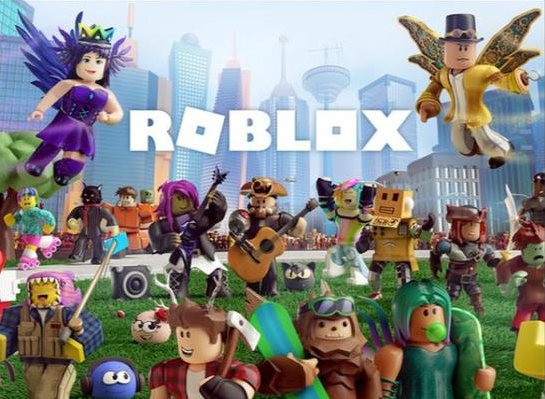
Some companies have already tried. Roblox, a hugely popular children’s game, lets players bring their avatar into thousands of different “experiences”, which are mostly simple games designed by other children. But Roblox is not the Metaverse either. You can’t take your Roblox avatar into a different game. Nor can you use the virtual items you paid for anywhere except for Roblox.
What would it look like if you could? Most advocates of the Metaverse point to books and movies like Ready Player One, a dystopian science-fiction story where there is a single persistent world that everyone plays in all the time. (It’s worth noting here that the bad guys in the story operate their own completely independent virtual world that nobody seems to play, so they are hell-bent on cheating in order to wrest control of this dominant Metaverse away from its founders).
Apart from the fact that nobody should want to live in a dystopia, there are a few problems with wanting to create a real-life Ready Player One:
Problem One: nobody wants to play only one game
The Metaverse presumes that a single company operating a single video game platform would become so dominant that nobody would want to play anything else. In real life, new video games come out all the time, and trends shift back and forth. Fortnite came out of nowhere and became hugely popular, but not everyone plays Fortnite. Why would gamers want to limit themselves to a single title forever?
Problem Two: having different types of games interoperate is impossible
Nobody (least of all the author) ever explains how the gameplay in Ready Player One would be balanced, or even work at all. You can purchase virtual guns and combat armor, so how would that work in a fantasy setting, or a medieval farming simulator? There seem to be no limits on jumping from world to world. If there were, and you could lock out the sci-fi combat troops from your farming game, how is that different from just playing a separate game entirely?
Problem Three: pay-to-win is no fun and people hate it
The integration of items that cost real-world money into games has always been a disaster whenever any games company has tried it. Blizzard’s Diablo III launched with a “real money auction house” where players could sell their loot to other players. This ended up destroying the fun of the game, because the best move was always to buy the most powerful equipment at the start and roll through all the enemies unimpeded, rather than, you know, playing the game. Everyone hated it and Blizzard quickly ripped it out of Diablo forever.
But the Metaverse implies a real money auction house, not just for one game, but for everything. The end result would be that rich people would win all the time and everyone else would get killed by the rich people over and over again, with no chance of victory. How is this fun? Why would anyone play this?
Problem Four: people don’t want to spend all day in VR
There is no evidence that people want to spend all of their time in virtual reality. I have a VR headset myself, and I really enjoy playing games on it. Mostly I play quick movement games like Beat Saber, or larger role-playing adventures like the VR version of Fallout 4. But I find playing VR to be tiring, so I limit my game sessions to about an hour or so. It’s hard on the eyes, and most games can’t be played sitting down. Even if headsets get lighter and more powerful, which they will, I don’t think people will want to be in VR all day, every day. I certainly don’t, and I love the technology. So a “Metaverse” that is VR-only will have a limited audience.
Problem Five: companies will never cooperate to make one company rich
In order for “many companies” to create a single Metaverse that everyone plays in, it would require that one company (Zuckerberg is hoping it’s Facebook) creates a virtual universe so attractive that everyone else would give up trying to make their own games and just make content for Facebook’s universe.
This is the Roblox business model. It works when the labor is cheap or free (in this case, it’s literally child labor) but it doesn’t scale past Roblox’s very limited and simple games. Nobody is going to want to make Diablo V or Fortnite II, spending hundreds of millions of dollars to do so, and then hand over 95% of their profits to Facebook.
The only way this could work is if somehow all companies could agree to a single standard for the Metaverse to use. This would not only require a standard game engine (say, the Unreal Engine owned by Fortnite creator Epic Games) but also a huge list of standard ways that the game would be built and how every part would talk to each other. These standards would have to be agreed upon and could never change once they were, otherwise separate parts of the Metaverse would immediately break and stop working with each other.
This, too, will never happen. Standards take years, sometimes decades to finalize, and what large company would want to wait around for this to happen, when they could build their own Metaverse right now and keep all the profits to themselves?
So where do we go from here?
Make no mistake, companies both big and small are all building their own “Metaverse” products, and none of them will ever interoperate with each other. Why would they? Why would a company allow you to pay some other company for a virtual item or avatar, and then let you use it for free in their game, costing them time and money to support? They won’t.
So who is building a Metaverse right now? Facebook and Microsoft have committed to building one of their own, which by definition will not be Metaverses since they won’t interoperate with each other. Google and Apple will probably be right behind. In the meantime, Fortnite and Roblox exist, along with tons of smaller games that are each their own persistent world. The independently-built VR Chat is the most popular place to virtually hang out in virtual reality right now, despite Facebook releasing the first version of their own virtual reality chat program. People go where other people hang out. Facebook is popular because so many people use it, but this popularity did not transfer over to VR chatting. It’s just like when Microsoft released a phone that ran Windows, and people ignored it because it wasn’t as popular as the iPhone or Android.
But what about Web 3.0?
Some folks are pretending that a new thing called “Web 3.0” will somehow mean that all the problems I’ve listed above will magically go away and the Metaverse will arise naturally from the power of blockchain and cryptocurrency. This definitely won’t happen. Explaining why is another whole article, but for now I’ll point out that all blockchain and crypto adds to the discussion is a very slow public database that can’t ever be changed and is ridiculously expensive to operate. It doesn’t solve the interoperability issue (blockchain games currently cannot and will not ever work with each other) and it doesn’t solve the balance issue, or the corporate motivation issue, or any of the other issues I’ve brought up. Most of these “blockchain” games don’t even run on blockchains at all, because they are too expensive to use. They just loosely tie themselves to a new crypto coin or new non-fungible tokens, so they can get some quick investment money. Most of them are just scams.
To sum up:
- Facebook is building something it calls a Metaverse
- So are a bunch of other companies
- None of these games/social spaces/virtual worlds will ever interoperate with each other, because companies have no financial incentive to make this work
- Therefore, none of these worlds will ever be a Metaverse
- Therefore, the Metaverse won’t ever happen
Here’s my advice for you, if you’re thinking you need to invest into “The Metaverse” today. You don’t. Play the games you want, in VR or not in VR. Use the chat programs you want, in VR or not in VR. Don’t worry about a universal dystopia that can never happen. You don’t have to sell your soul to Facebook, or anyone else.
Views: 4893
New World: Update
Post #: 286
Post type: Blog post
Date: 2022-02-17 22:30:02.000
Author: Jeremy Reimer
Tags:
Well, it's been only a little over a month since New World was released, and the bloom is already off the rose.
A combination of crazy bugs and a rapidly-dropping player base (going from nearly 1 million concurrent players shortly after launch to under 250,000 today) has the future of the game already in question.
Seems like the post-mortem might come sooner than I thought!
EDIT: As of February 8, 2022, the game is down to about 45,000 concurrent players, most servers are ghost towns. and about half this population are gold-farming bots. The game is done; it's toast. I hate to say I told you so, but...
Views: 3207
The future of New World: Does Amazon Studios understand gaming?
Post #: 285
Post type: Blog post
Date: 2021-11-22 22:28:09.000
Author: Jeremy Reimer
Tags:
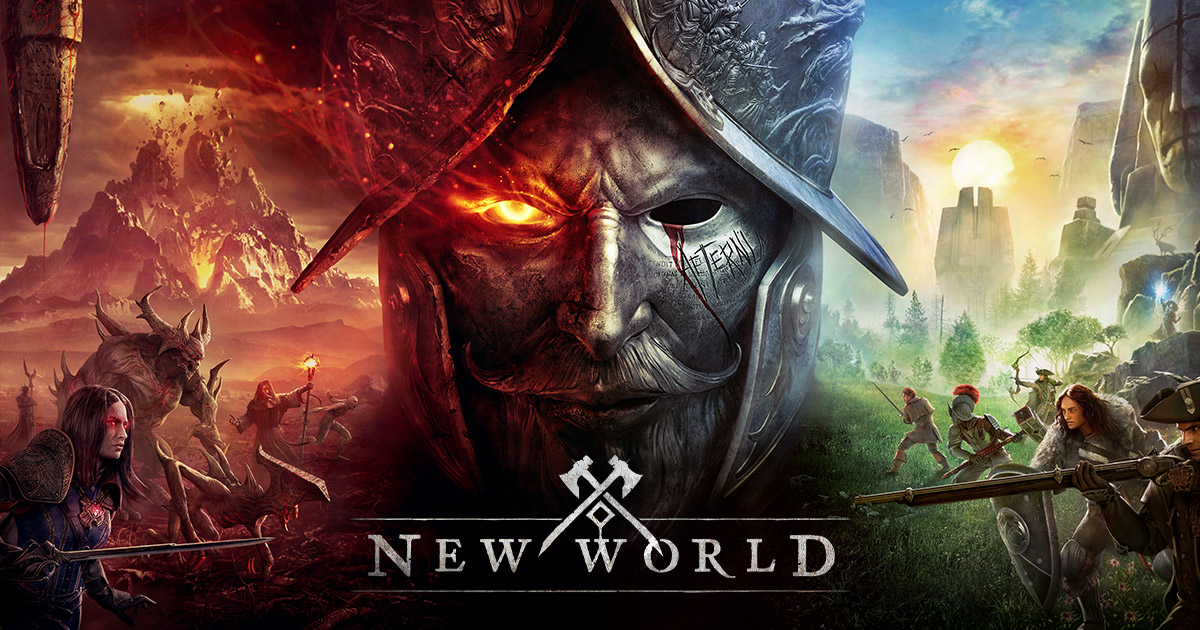
New World is a massively multiplayer online role-playing game (MMORPG) for the PC, made by Amazon Studios. It was released on September 28th 2021, and the big story surrounding its launch was the fact that the game servers were so overwhelmed that people had to spend hours and even sometimes half a day sitting in a login queue.
Scaling issues with game servers on launch day are common, and harder to solve than most people imagine. Full disclaimer: I work for a division of Activision Blizzard that handles online play, but my opinions in this article don’t represent that company at all. In any case, the server issues are mostly gone now, and they aren’t what I want to talk about anyway.
Jeff Bezos gave Amazon Studios a mandate to “dominate gaming”. After several years and hundreds of millions of dollars spent, they had done the exact opposite of that. Their first title, Breakaway, was an online game where two teams tried to put a ball in their opponents’ goal while physically fighting them off. It was announced in 2016 but cancelled in 2018. The studio’s second title, Crucible, was a hero-based team shooter in the vein of Overwatch or Team Fortress 2. It was actually released in 2020 but then un-released a few months later due to low player count.
So the third game, New World, had a lot of pressure on it to succeed. One or two failures can be written off as learning experiences, but three failures become a pattern. Amazon was determined not to let this happen. Because the company owns Twitch, the dominant game streaming platform, they could easily incentivize Twitch streamers to play New World, and even more easily promote these streams to the entire Twitch audience. Watching entertaining people having fun playing games with their friends is a huge motivator to buy a game.
And it worked! So many people bought the game that the servers buckled on launch day. Even now, a month later, there are still tons of people playing the game. You can log into any server and see a lively world populated by thousands of players.
So Amazon must be breathing a sigh of relief. They finally shipped a massive hit, and can continue on with their mission to dominate the gaming landscape. Right?
Not really.
New World is certainly a hit, for now. But the game is unlikely to find long-term success. More importantly, I don’t think Amazon Studios has learned what it takes to make hit games, because New World succeeded for the wrong reasons.
Let’s look at the game itself to figure out this contradiction. Firstly, the positives: the game looks gorgeous, it has a large and lush world for players to explore, the combat has the potential to be interesting, there are lots of other people playing it, it has a complex and potentially interesting crafting system, and there are many opportunities for both player-versus-environment (PVE) and player-versus-player (PVP) conflicts.
That’s the good stuff. Now for the not-so-good stuff. New World doesn’t really have an underlying story. This isn’t a small thing, and it can't be patched in later.
The game starts off with a cinematic of a silver-masked man getting a mysterious item from a hooded stranger on board a sailing ship. You, the player character, are also on this ship. The ship crashes on the shore of an unknown magical island and most of the crew are killed. You, the player, must fight evil corrupted zombie crew-mates and make your way to civilization, where friendly townspeople will give you tasks to go kill wildlife, chop down trees and hit rocks, and join one of three indistinguishable factions.
And that’s basically it.
It’s not clear what anyone’s ultimate objective is on this magical island, where some people (the players) can never be killed and others turn into generic zombies. Leveling up and looting treasure, sure, that’s a given. But to what end? Perhaps there’s some Big Bad Boss lurking out there that you’ll eventually have to team up to defeat, but there’s no evidence of this in the first twenty hours of play. And the factions that you join don’t seem to matter at all. Join one, and you’ll get a yellow, green, or purple icon above your head, and can participate in massive battles (that don’t happen in the main world) that can maybe swing the affiliation of a sector of land towards or away from your faction. But since anyone can walk into any town that has any color of banners flying from the rafters, why should the player care? My starting town switched factions twice since I began playing, and it didn’t seem to affect any of the non-player characters (NPCs) or the quests they gave me. It doesn’t help that every city has an identical layout, either.
Beyond this massive oversight, the game itself has tons of different systems, and most of them work fine, but none of them are outstanding. There’s nothing that stands out about the combat, which has a block, dodge, and three special moves for each type of weapon. It feels like it could be more interesting than it ends up being in practice, because when enemies start to attack you and you’ve already started your own attack animation, you can’t stop to dodge or parry. So it ends up being mostly about skill levels and numbers. It’s like a MMORPG wanted to be Dark Souls and then realized that it had to be an MMORPG, so it landed in a solidly bland middle.
Speaking of levels, everything has a level. Every weapon skill can be leveled up by using them. Hitting rocks has a level. Chopping trees has a level. Sewing thread has a level. And the one thing in common with all these levels is that they start out advancing fast but then settle down into a slower and slower grind. How many more hundred levels do I need in chopping to cut down this harder tree? I don’t know. I may never get there before boredom sets in.
At the end of the day, New World is a very pretty MMORPG that doesn’t do anything in particular better than any other game. There are MMORPGs with better crafting. There are some with better combat. Some have more interesting PVP. Almost all of them have a better story.
New World hit the market at a very unique time: the exact point that a lot of people were tired of playing World of Warcraft and wanted something that was similar but looked better. New World was exactly that game at exactly the right time. Combined with Amazon’s built-in Twitch advertising advantage, it was poised for success. And it’s not a bad game by any means. It’s satisfying to level up a character and grind through a beautiful, lush world.
But in the long term, the missing story and lack of meaningful end-game content will cause players to drift off. There’s no monthly subscription fee, just a one-time purchase, so there’s no reason not to quit when it gets boring. If you enjoy playing with your friends, you’ll stop when they stop. The Twitch streamers will move on to the next great gaming craze. Eventually, the game will become a wasteland, and there is nothing sadder than an MMORPG with nobody in it.
Why didn’t Amazon Studios do a better job with New World? They had near-infinite amounts of money to spend. They had skilled talent that Amazon lured from other game studios. What they didn’t have was a mandate from the top that was anything more than “go dominate”. What do you do when given such marching orders? You spend money and you hire talent. But to what end? Since it’s not clear, you look at games that “dominate” now and try and make games that have the same systems, but “better”. But what does “better” mean, exactly? New World has great graphics, lots of combat and crafting systems, and PVE and PVP content. But it’s missing that spark, that understanding, that sense of what good games can be when backed by leadership who live and breathe them.
Jeff Bezos doesn’t understand games, so he can’t give Amazon Studios the inspiration that it needs. Since the only thing he wants is numbers, Amazon Studios will find a way to deliver those numbers. At least for a while.
Views: 3064
A new photo, a new banner, and a new mission for the blog
Post #: 284
Post type: Blog post
Date: 2021-10-12 18:30:18.000
Author: Jeremy Reimer
Tags:
Eagle-eyed viewers of this blog have already noticed the shiny new banner up top, along with a nice new headshot of yours truly. That photo is courtesy of a good friend of mine, expert photographer Stephen Mirowski.
I've been neglecting my blog while I concentrated on my newsletter, Arcade Dreams, and other personal projects. I think it's time I changed that. Blog writing isn't a quick path to success (and one could argue that it never was), but it's still fun, and it's a great way to keep in touch with your audience.
And I still have some things I want to say, about video games, about science fiction, and about life in general.
So stay tuned!
Views: 3893
No Time on Titan - a short story
Post #: 283
Post type: Blog post
Date: 2021-05-20 18:56:59.000
Author: Jeremy Reimer
Tags:
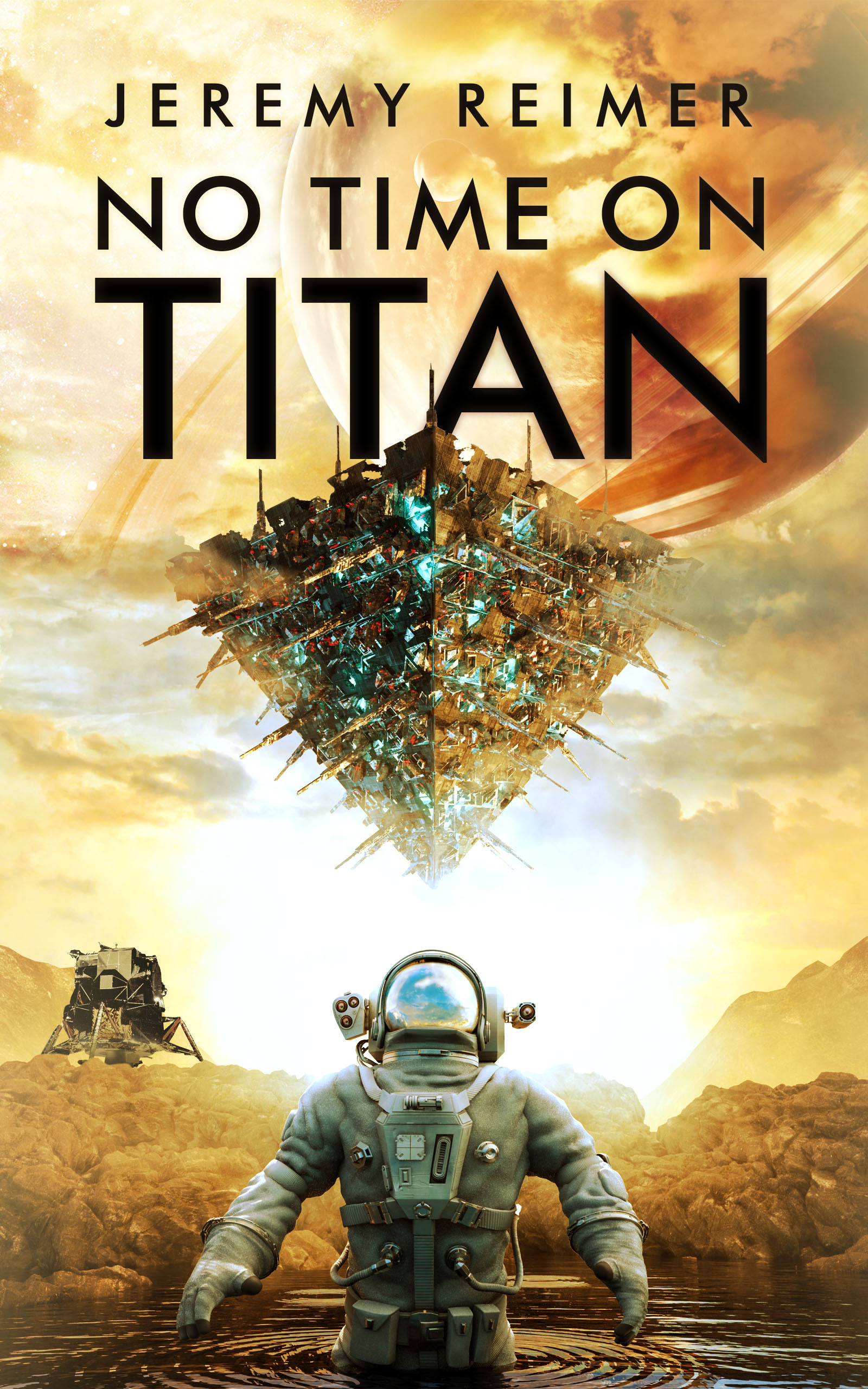
Titan is one of the most interesting places in the solar system. It’s the largest moon of Saturn, and its cloud-covered atmosphere is nearly as dense as Earth’s. If you landed on Titan with nothing more than a (very) warm coat and an oxygen mask, you could walk around the orange-colored landscape.
In No Time on Titan, a short story set in the same universe as my Silicon Minds series, biologist-turned-astronaut Lyesha Brown gets to do just that. But this once-in-a-lifetime opportunity is marred by corporate skullduggery and a mysterious death. Lyesha must sail the dark liquid methane seas and uncover the mystery of Saturn’s largest moon, before it’s too late.
It’s fast-paced and fun. Please check it out at one of your favorite retailers:
Amazon
Apple Books
Kobo
Barnes and Noble
Views: 3152
The most obscure video game ever made
Post #: 282
Post type: Blog post
Date: 2022-10-26 17:14:51.000
Author: Jeremy Reimer
Tags:
I'd like to tell you a story about the most obscure video game ever made. Only one person in the world has ever played it, and until now, only one person in the world has ever even seen it or heard about it. It's a game called Balablox, from 1987, and it ran on one of the most obscure computers ever, the Heathkit H-89. This one, in fact: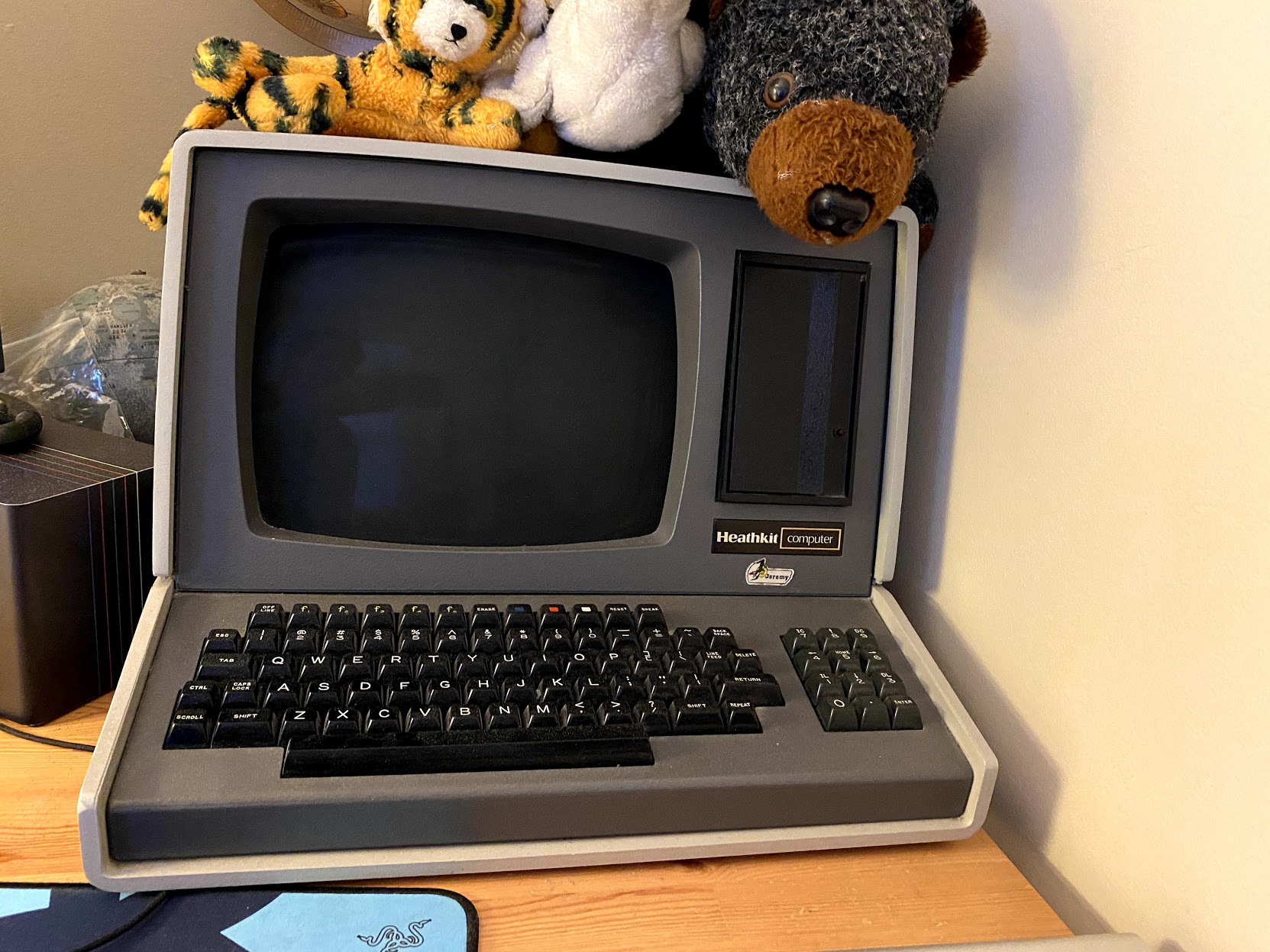
I got this computer in 1979, when I was 7, and started making games in Microsoft BASIC. By 1987 I was 15, and eagerly awaiting my new Packard Bell PC/XT clone. But before I entered the PC age, I finished one final game on the Heathkit. It was loosely based on the short film Balablok, from the Canadian National Film Board or NFB. Here's the loading screen: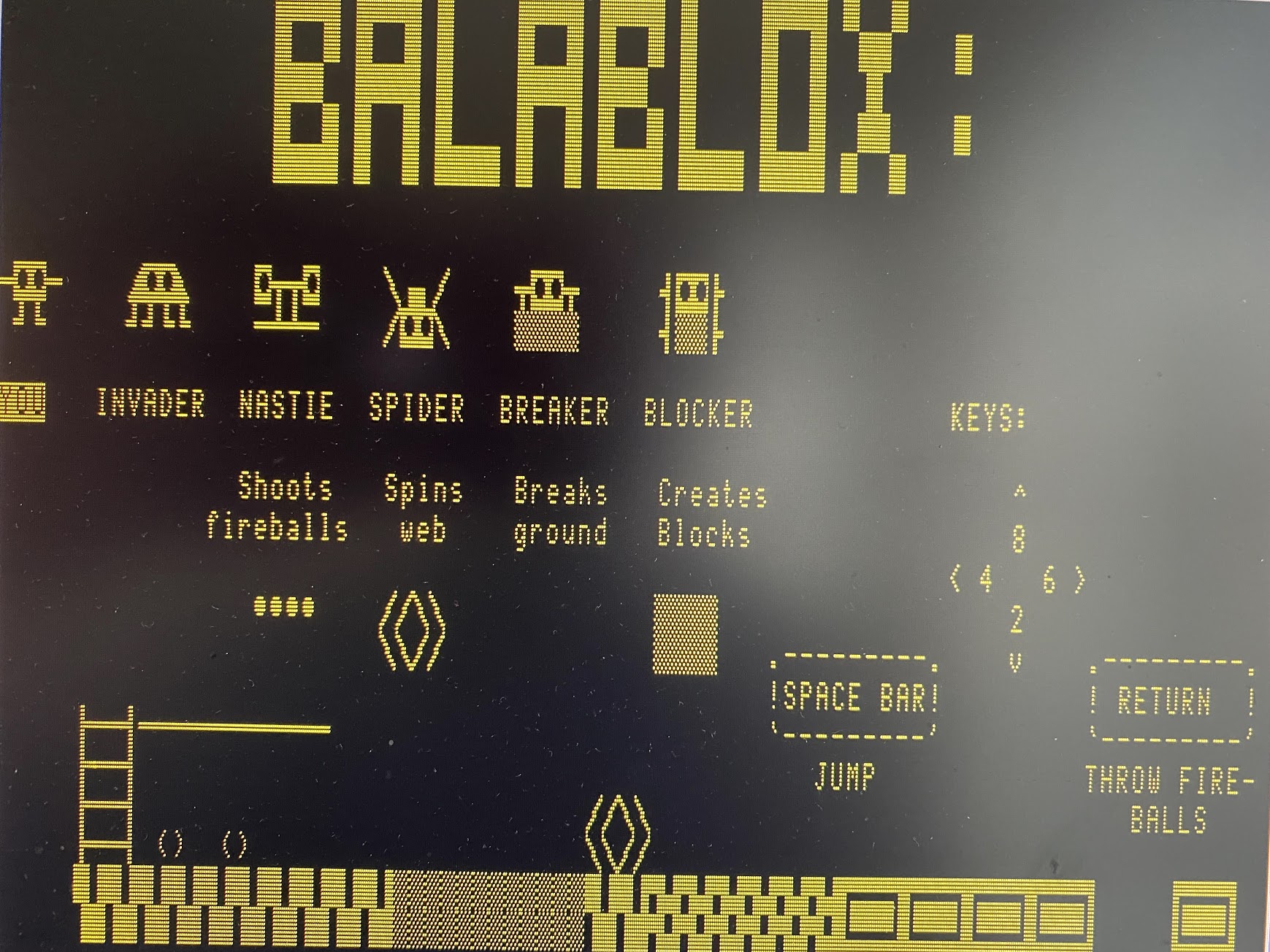
You play a small square creature, running and jumping to get the key and escape each level, while being assaulted by monsters. It's a bit like Lode Runner, but the monsters have special attacks. Here's the first level:
The game is slow (interpreted BASIC on a 2MHz Z80!) and hard, but you can beat all 15 levels. The H-89 buffers keystrokes, so you can hit left while falling from a jump and then hit space bar, and you will jump to the left once you hit the ground. Here, you're crossing a zipline.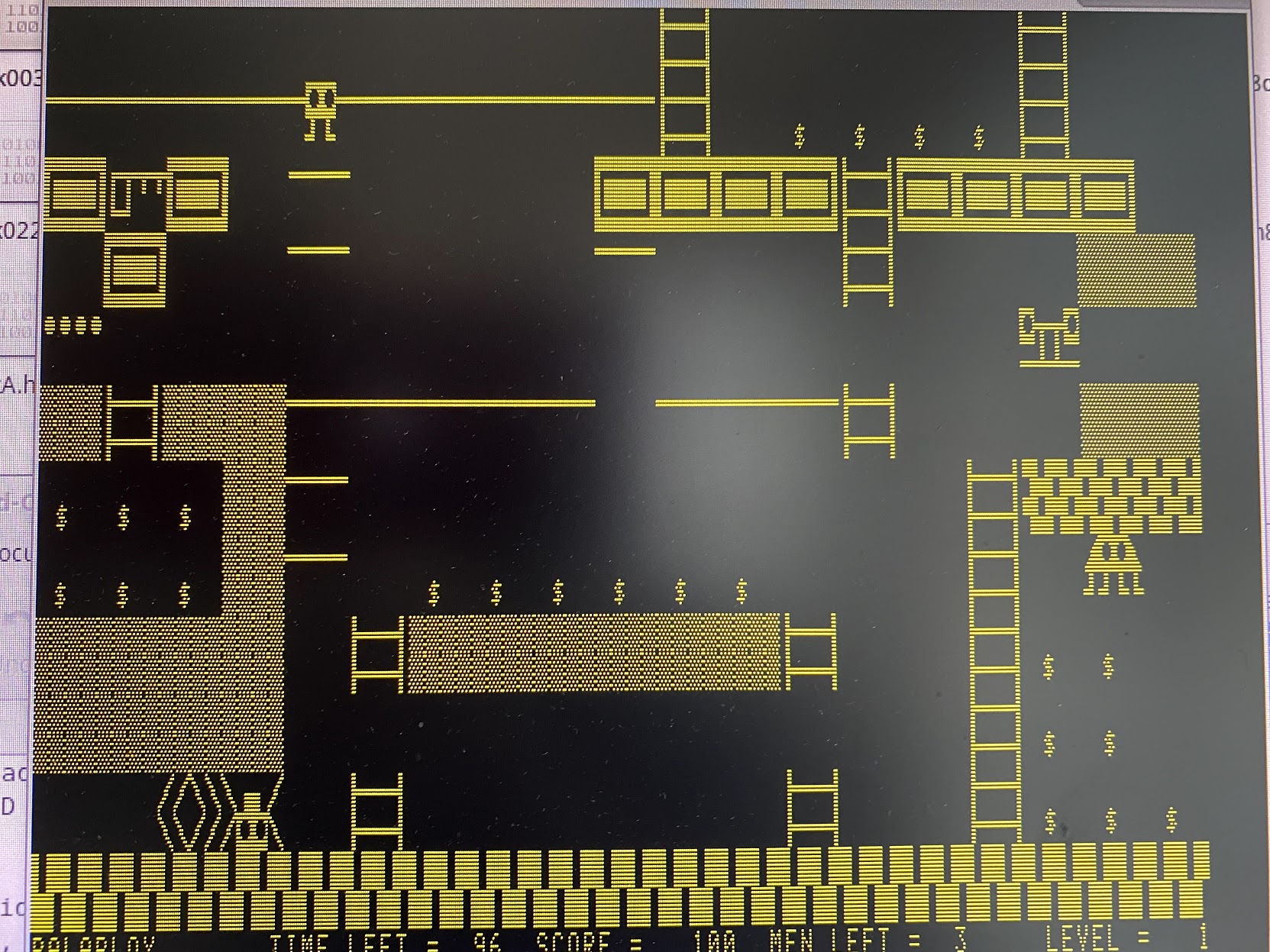
The game has a level editor, so anyone can make new levels. Of course, being 15, I had to include the Starship Enterprise. This is level 7. The key is on the front deflector dish. The diamond gives you the power to shoot up, destructively.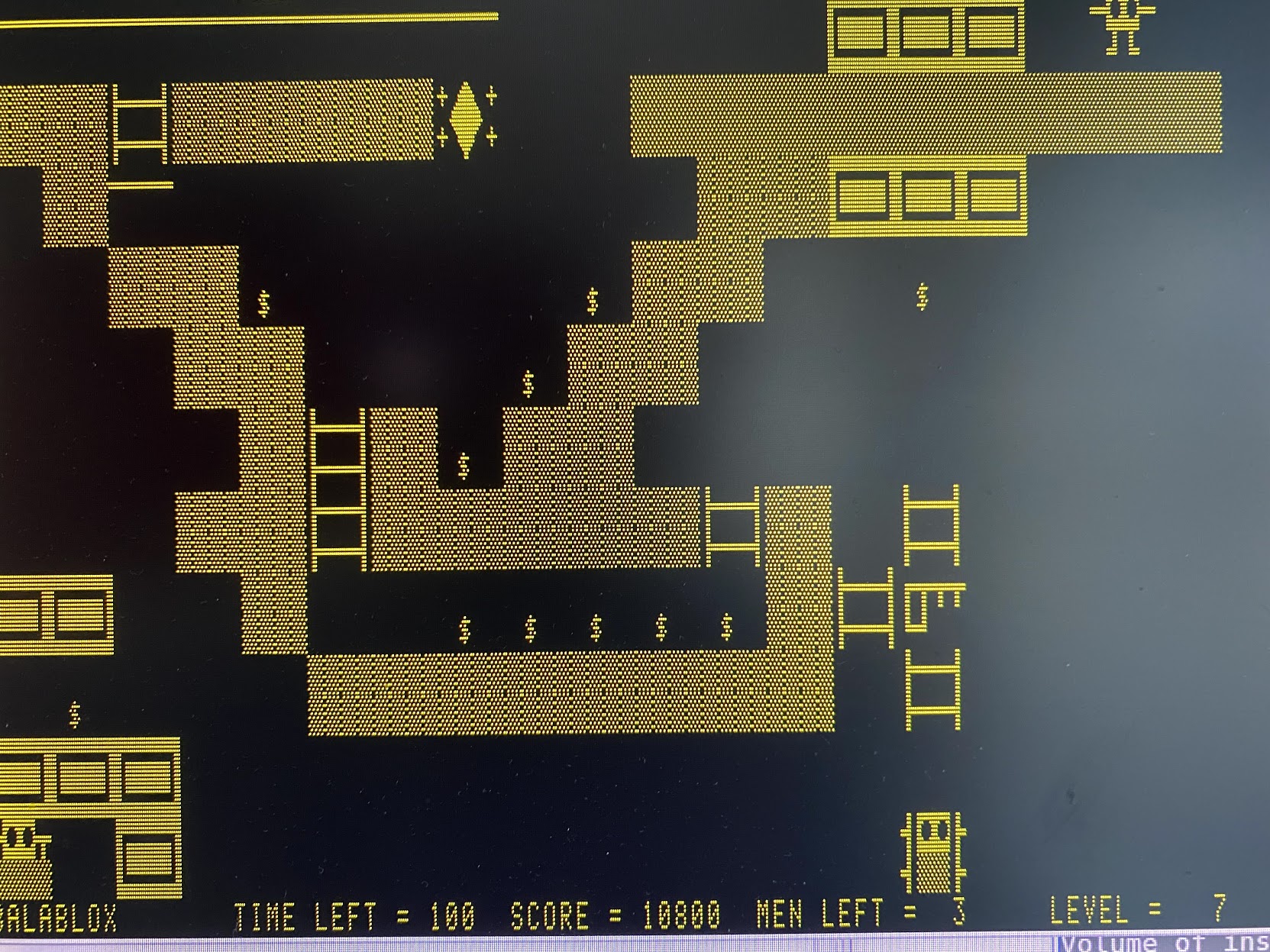
Here, in level 8, a spider guards the entrance to the bottom lair. The spider web will stop your movement for a time, and other creatures might eat you. There are eight "invaders" in the middle, but only one will move. If you touch any of them, you die.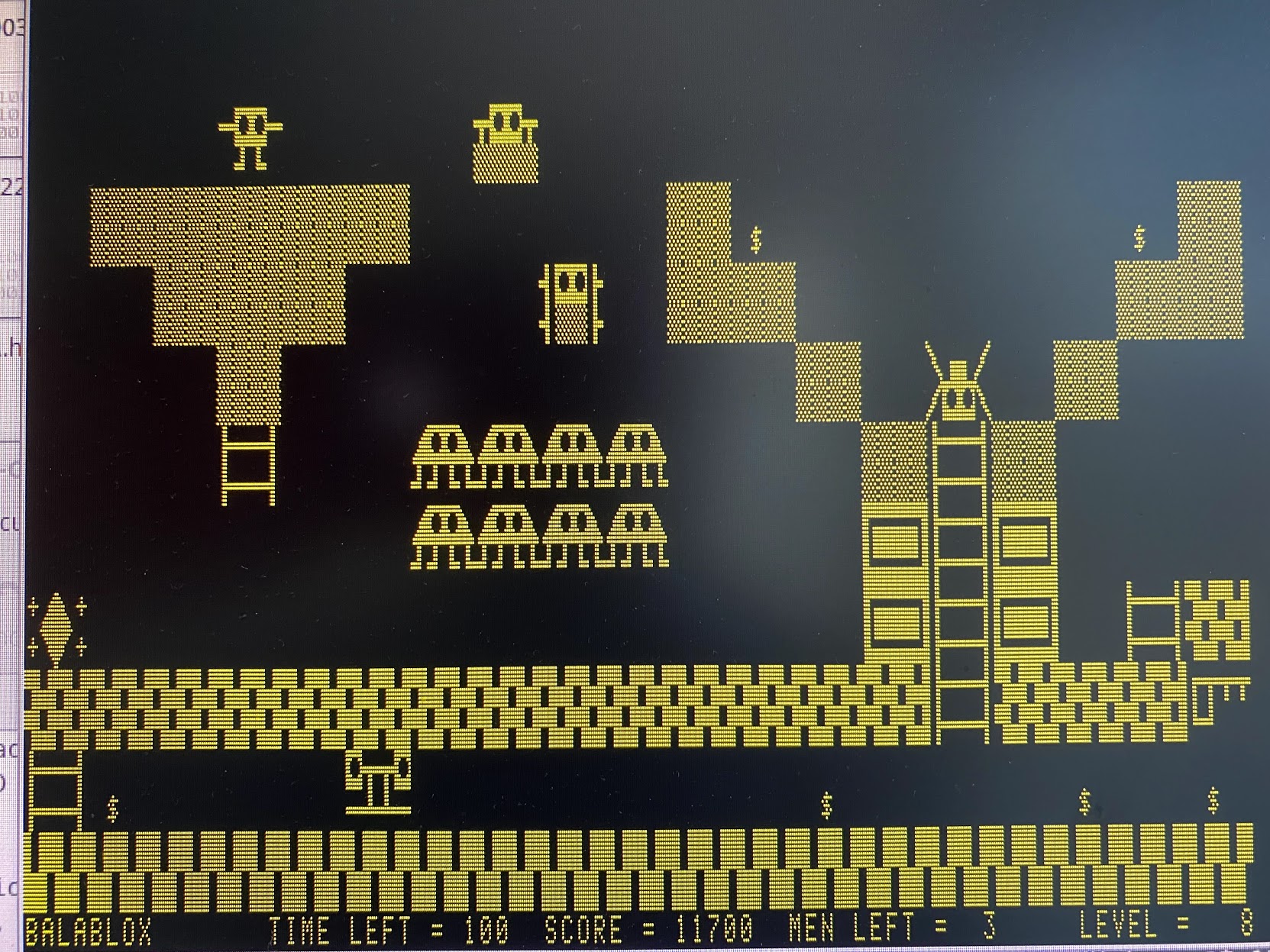
Level 9 is the first really difficult "gating" level. You can't get to the key right away. You have to hope that the nastie shoots a fireball, clearing other level blocks and (temporarily) enemies so you can run to the right and jump up. But the blocker might block your path.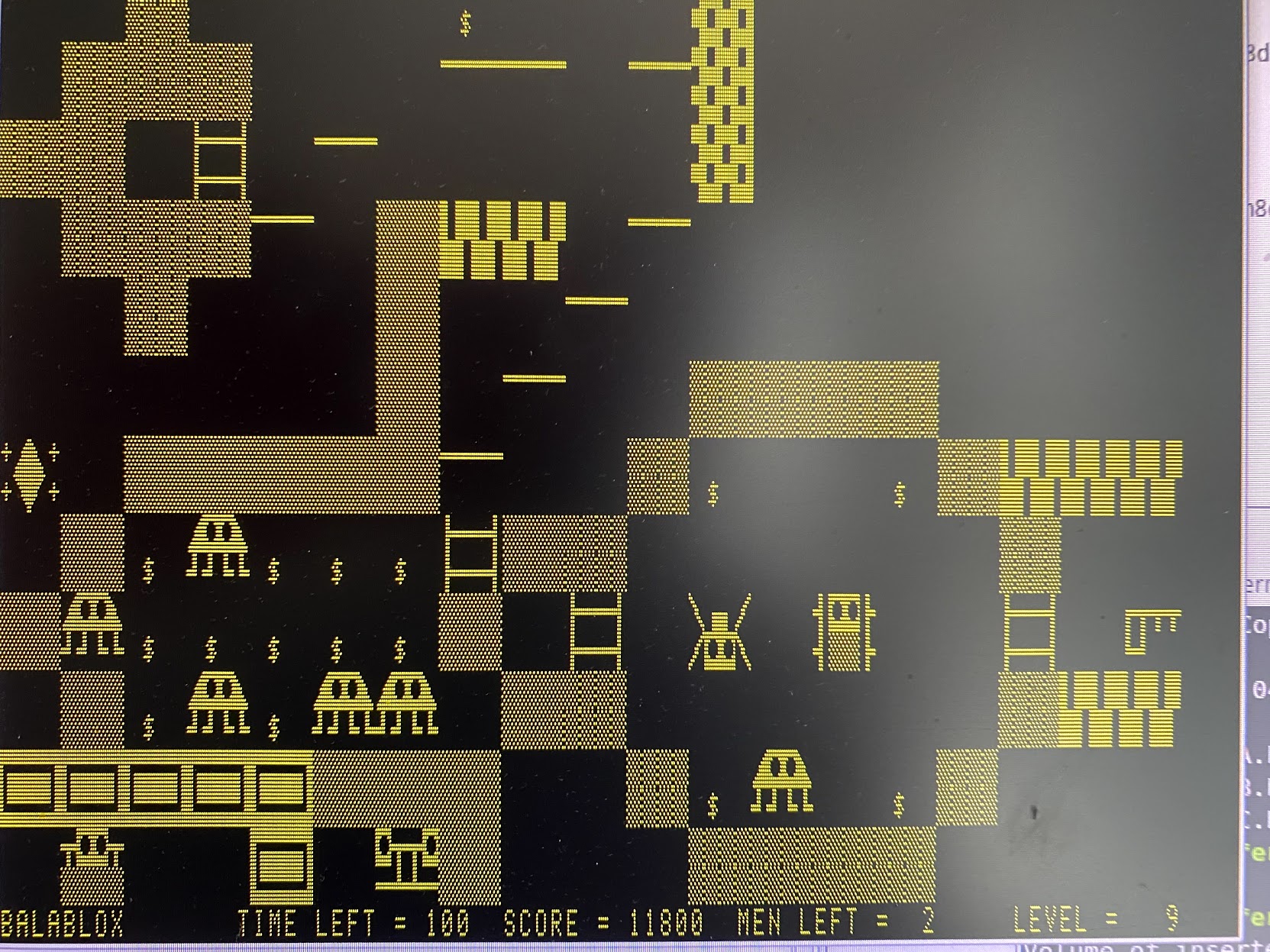
I couldn't get past this level in 2021, but at least I got a high score. Note the hilarious high score entries from 1987.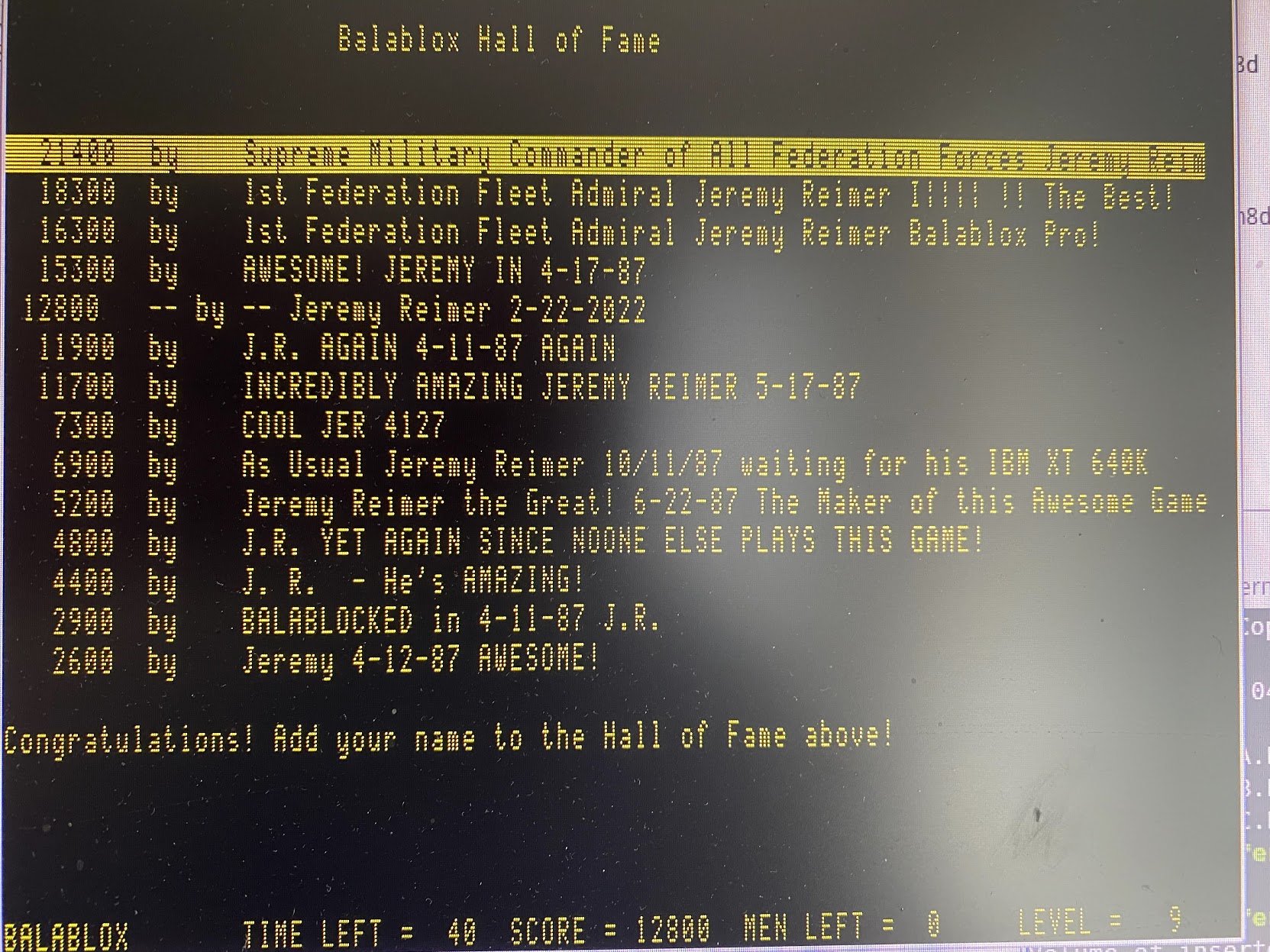
Let's look at the source code. DEFINT A-Z makes all variables integers, vital to get enough speed when running in interpreted BASIC. The command RANDOMIZE(PEEK(11)) seeds the randomizer with a bit from the system clock. All graphics are character graphics, since that's all the Heathkit supports. They are stored as strings. The map is a 20x12 grid (the screen is 80x24, and each block is 4x2). X$=INKEY$ reads the keyboard.
The main game loop reads the keyboard and sets walking directions, updates enemies, webs, fireballs, plays a bell (CHR$(7)) when you hit a coin, and checks if you have finished the level. My uncle taught me about main game loops. They still exist today!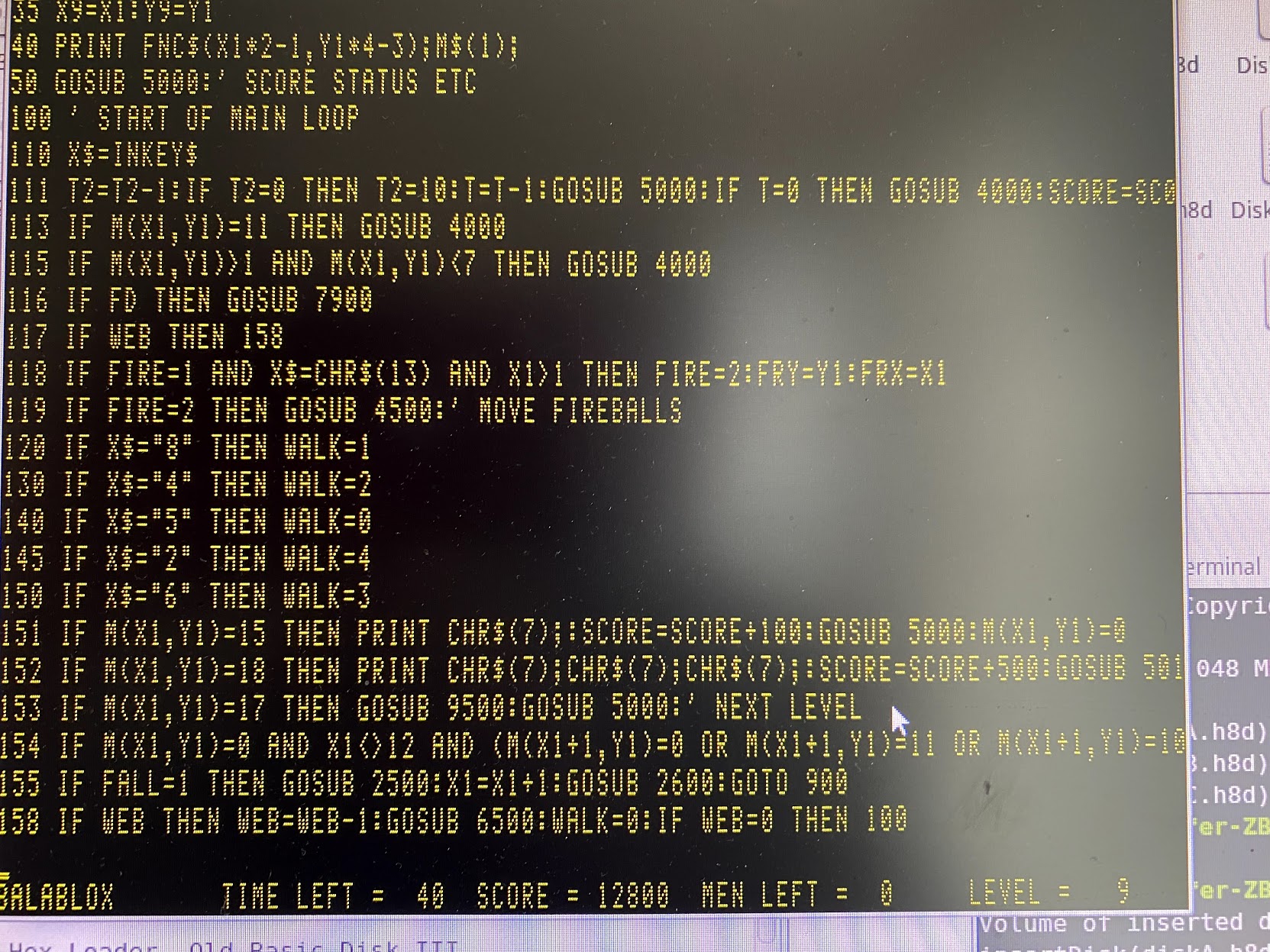
Here I'm assigning all the graphic elements. The H-89's character graphics required entering a special mode using an escape sequence, which changed all the lowercase letters into symbols. DL$ is a string for down 1 and left 4 chars. Updating the screen is just a matter of printing strings, which makes it fast enough (barely) to have an action game using interpreted BASIC.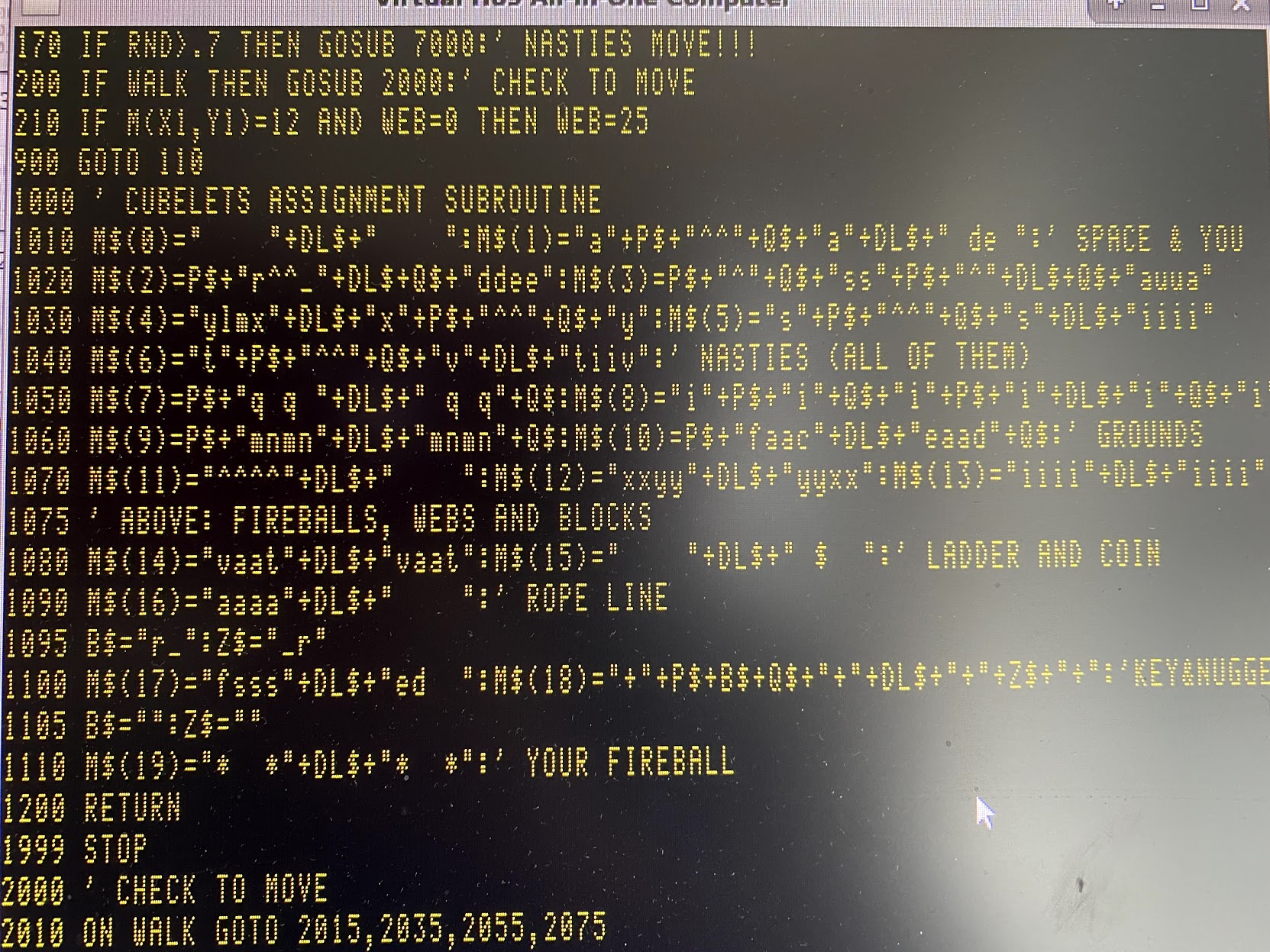
Here I'm checking if the character is able to move in a given direction, or jump.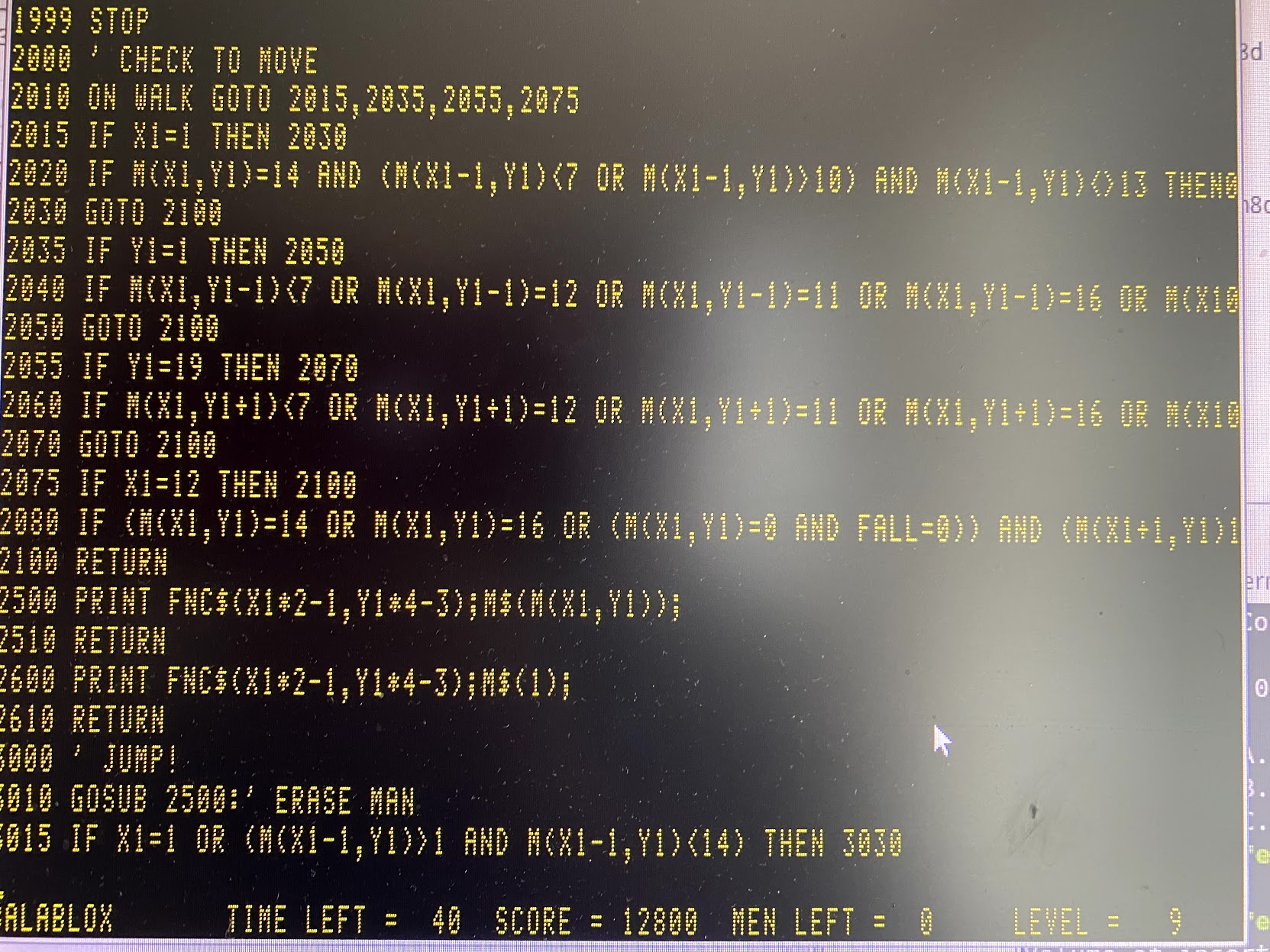
Line 5000 updates the status screen on the 25th line. The emulator has a bug that scrolls the screen when you print anything on this line, but I patched the game (34 years later!) to work around it by adding a ; to the end of line 5020.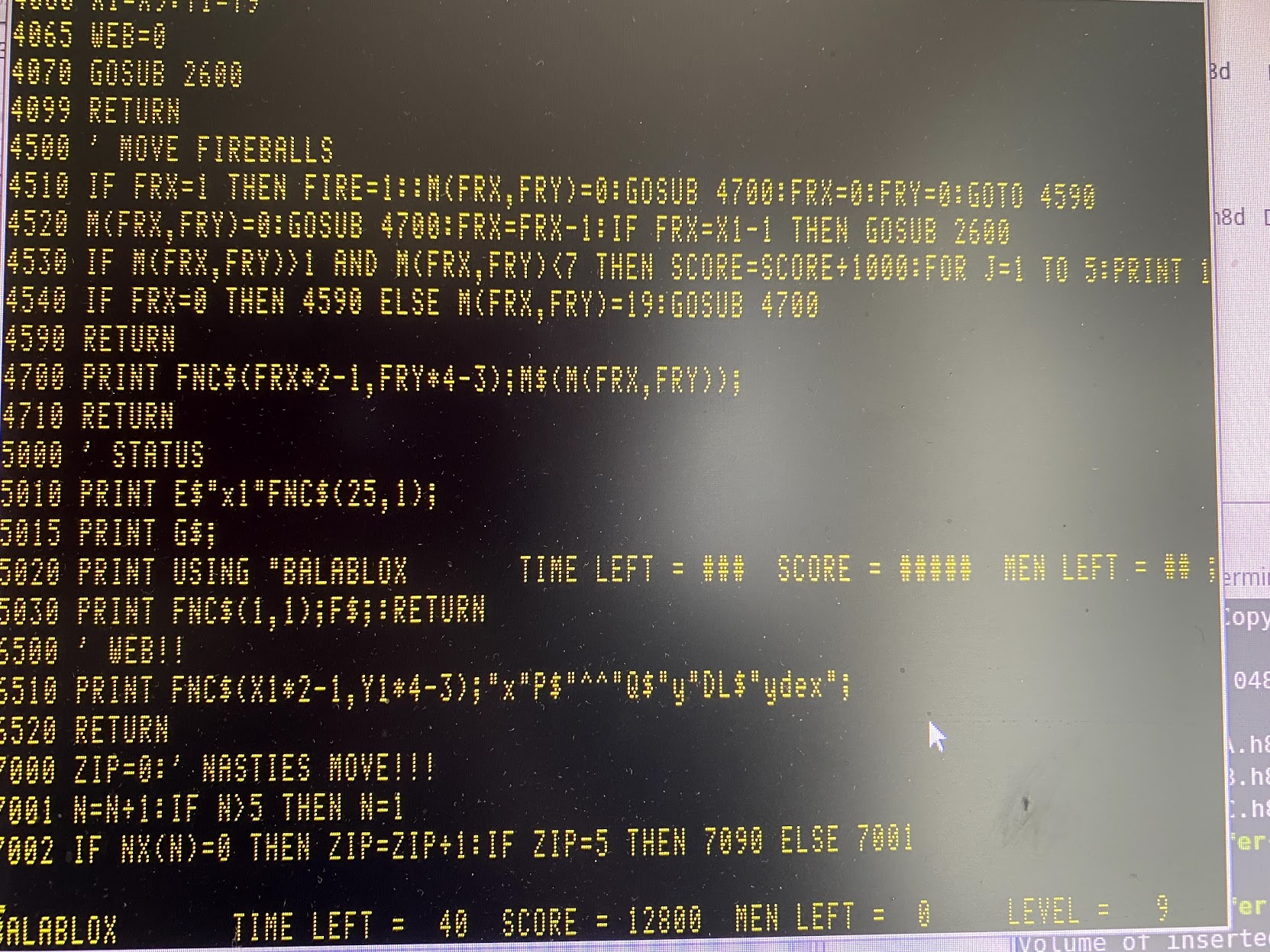
Monsters have a 50% chance to do their special move and a 50% chance to move towards the player instead of randomly. I did zero tweaking for this. It just seemed to work.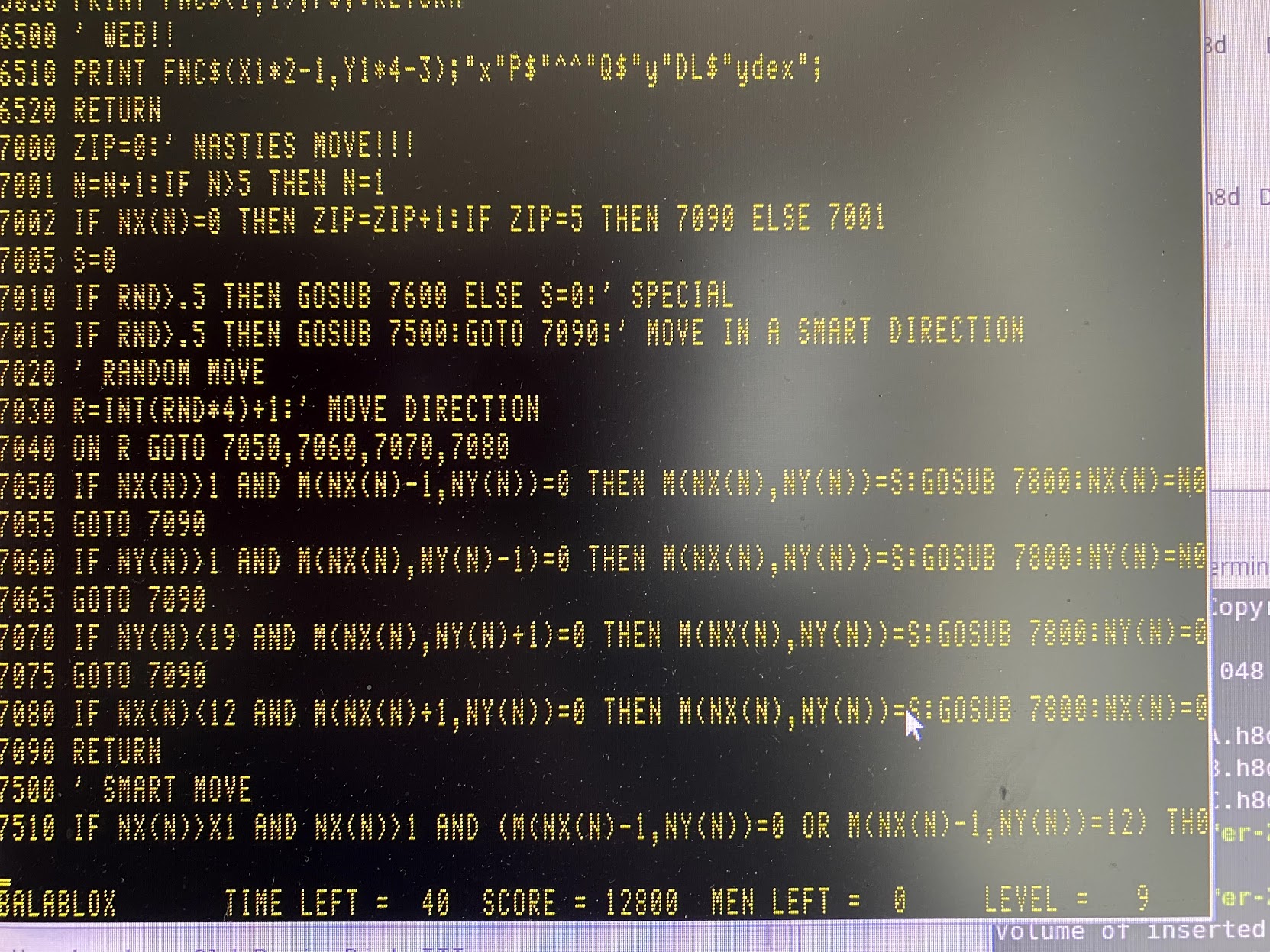
The game came with a level editor, which is happening at line 8000. Cheeky 15 year-old agnostic me is having fun with the comments.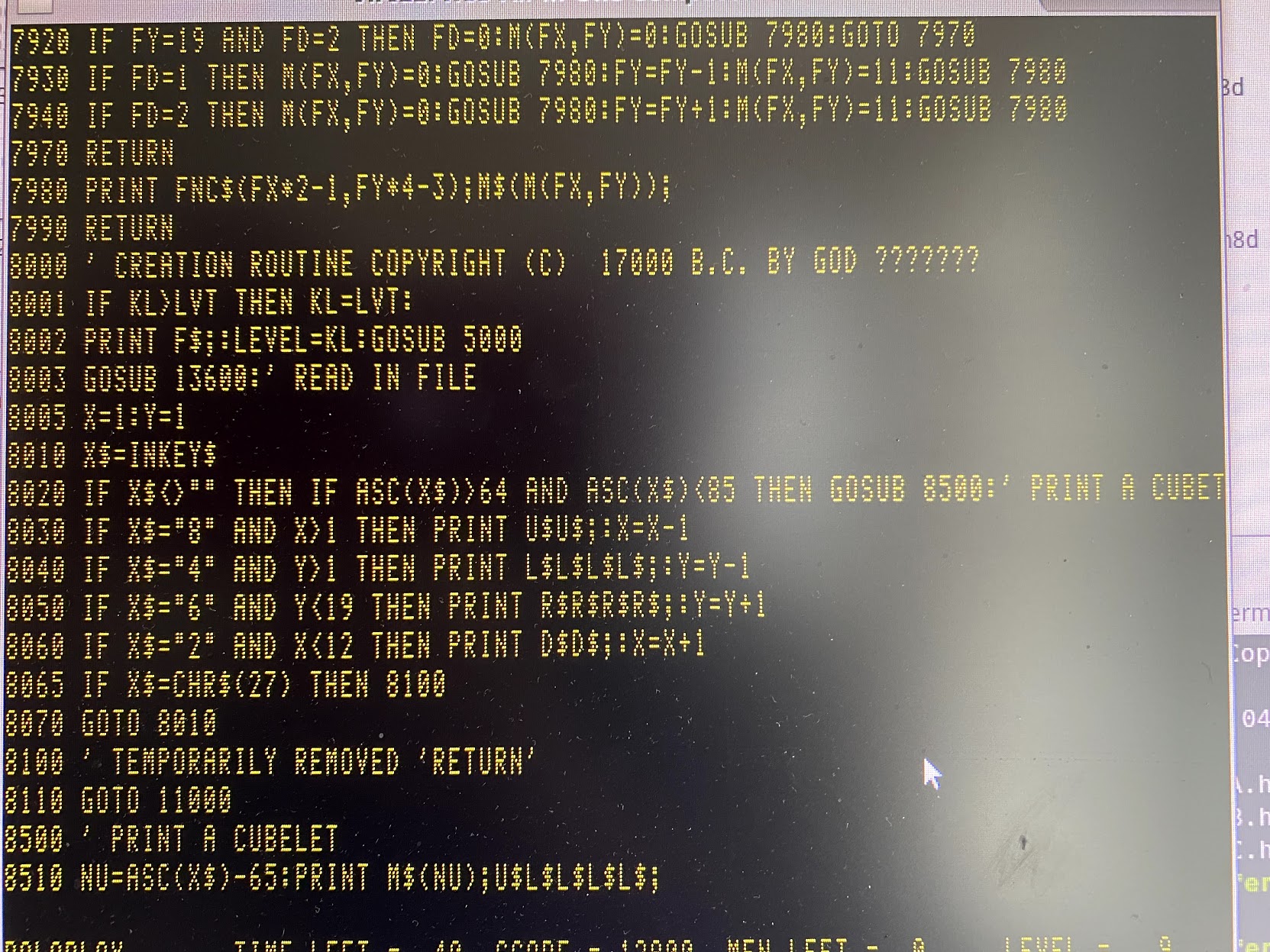
Line 9000 and on is computer-generated code, from a program called SKETCH that let you make a screen out of character graphics and save it as BASIC source code. I used it here to make the loading screen. Another command imported it into my code. I miss SKETCH. It was awesome.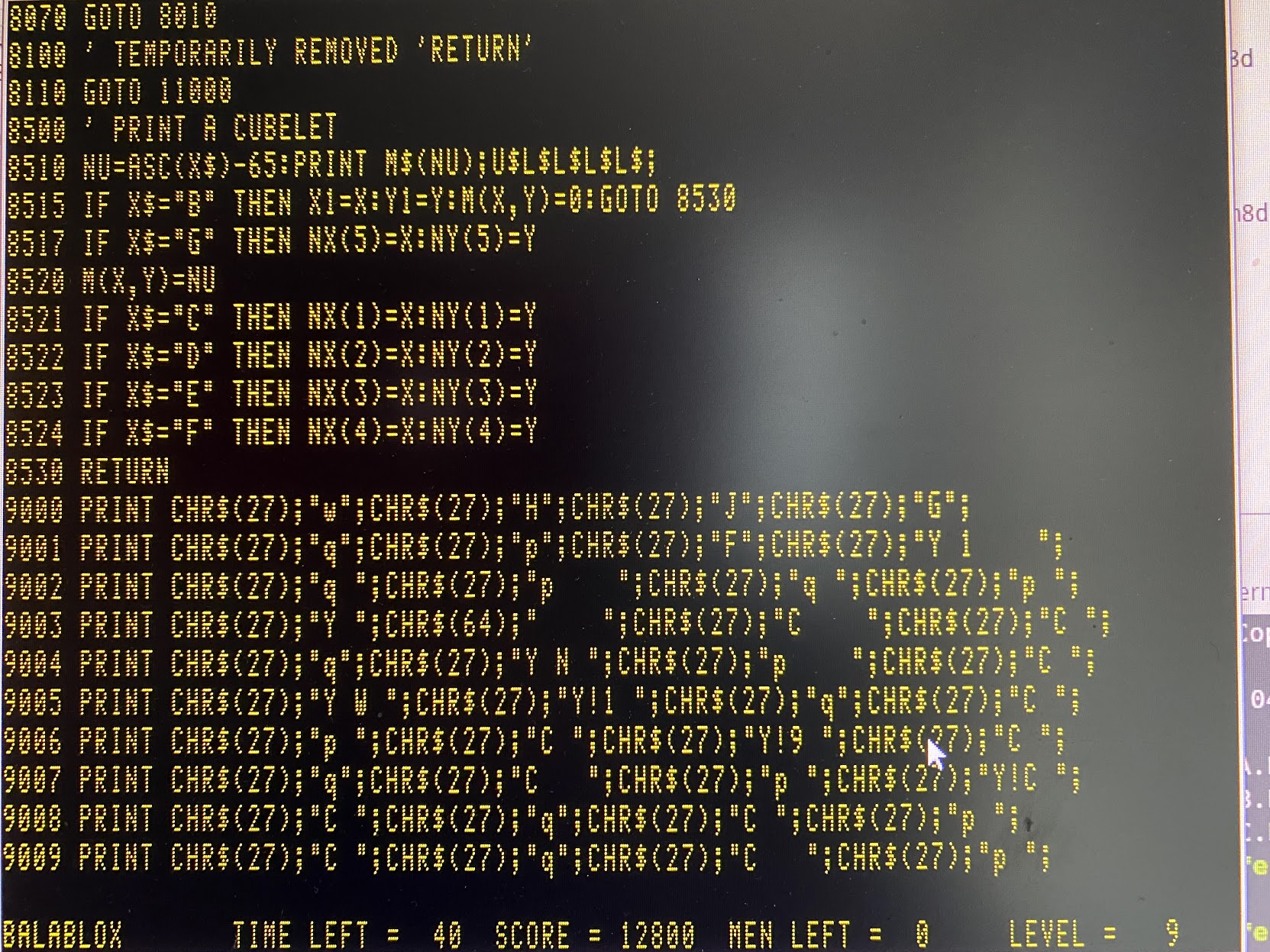
This code saves and loads level files and prints the main game menu, letting the player access the level editor or play any level directly.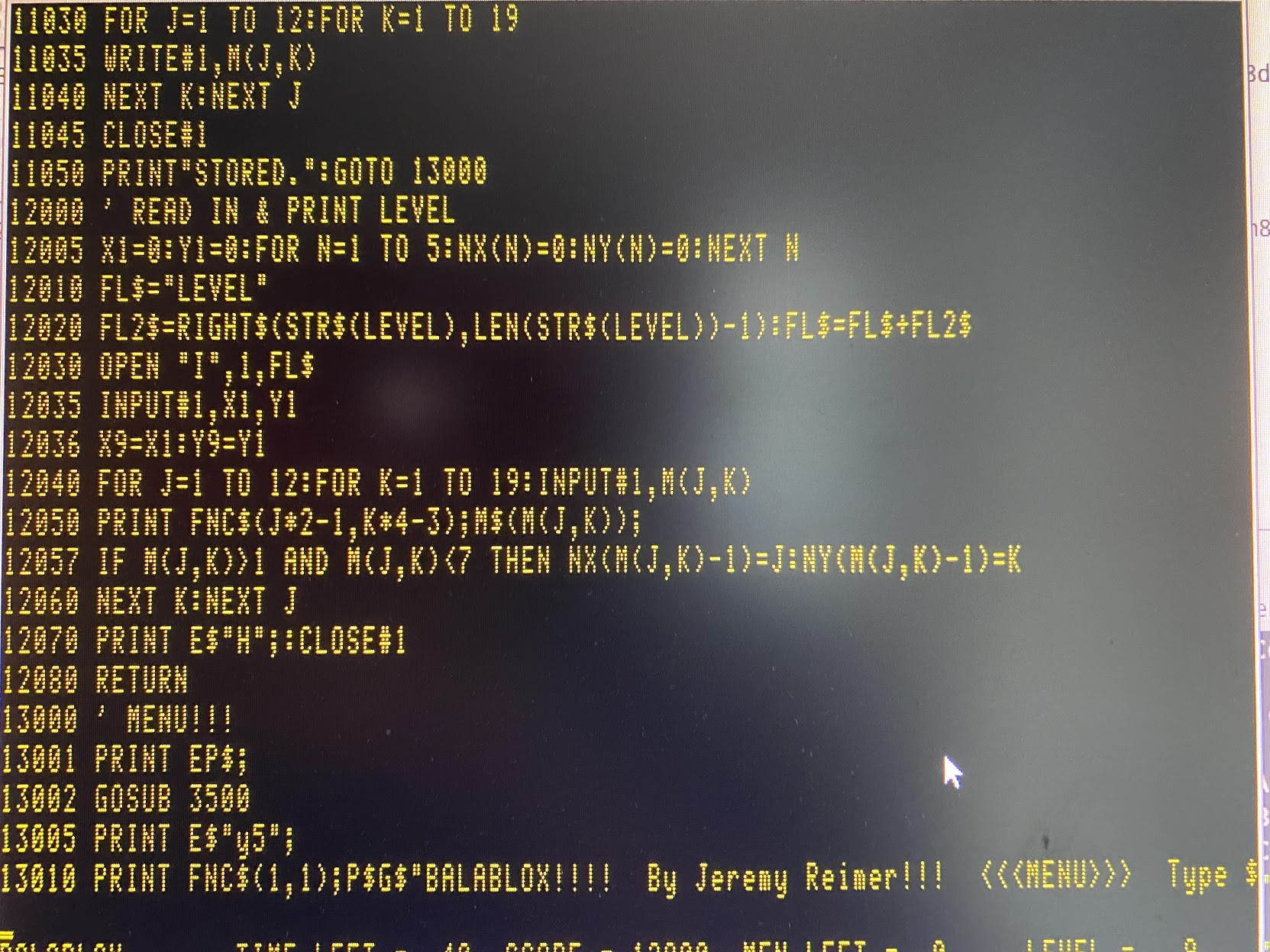
The hall of fame or high score screen. ON ERROR GOTO will make a new high score table with two entries called "NAMELESS, JR" if one doesn't exist.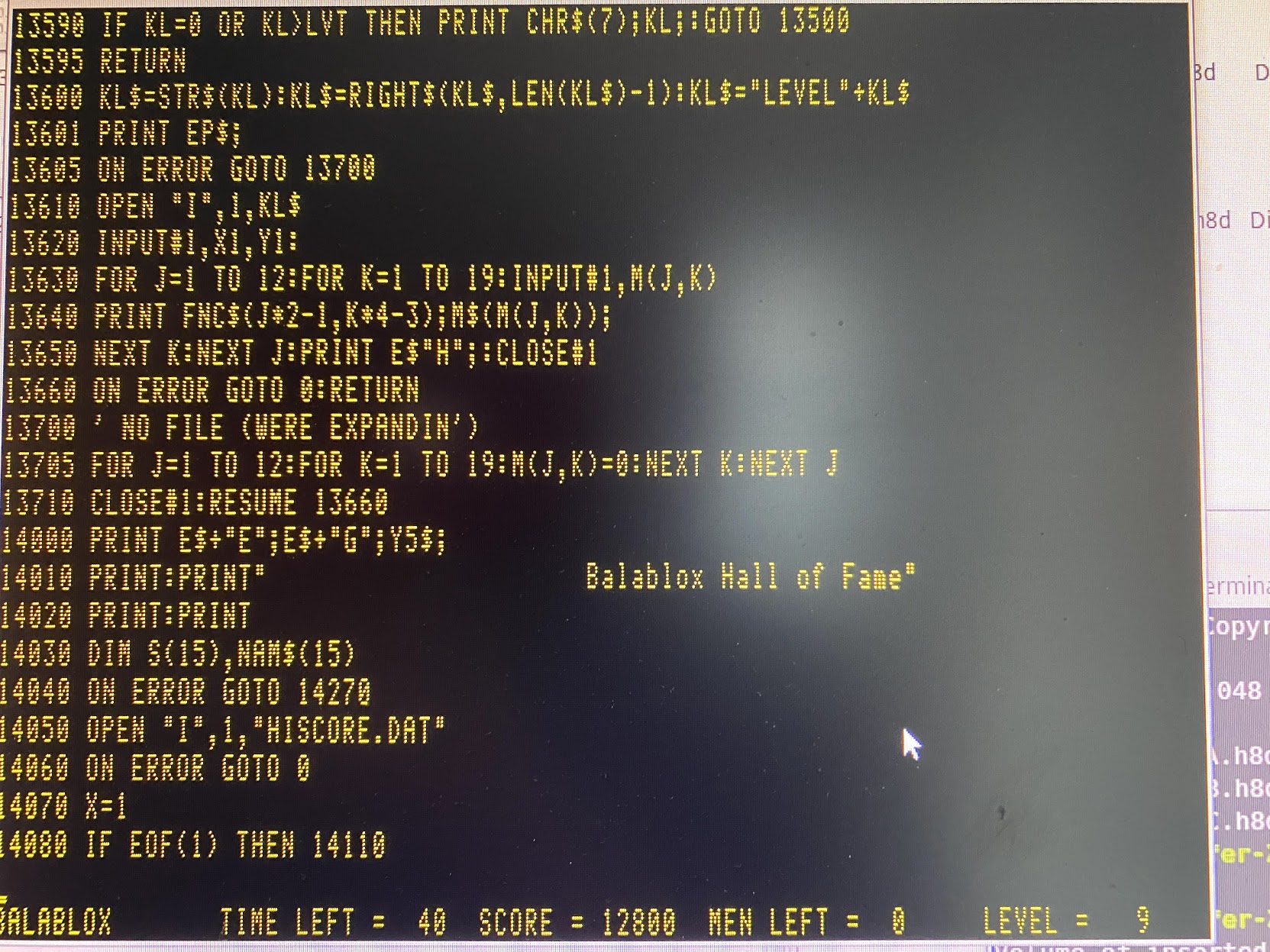
There's a simple nested loop sort routine to order the high score table. Not very efficient, but it gets the job done. And that's the end of the code!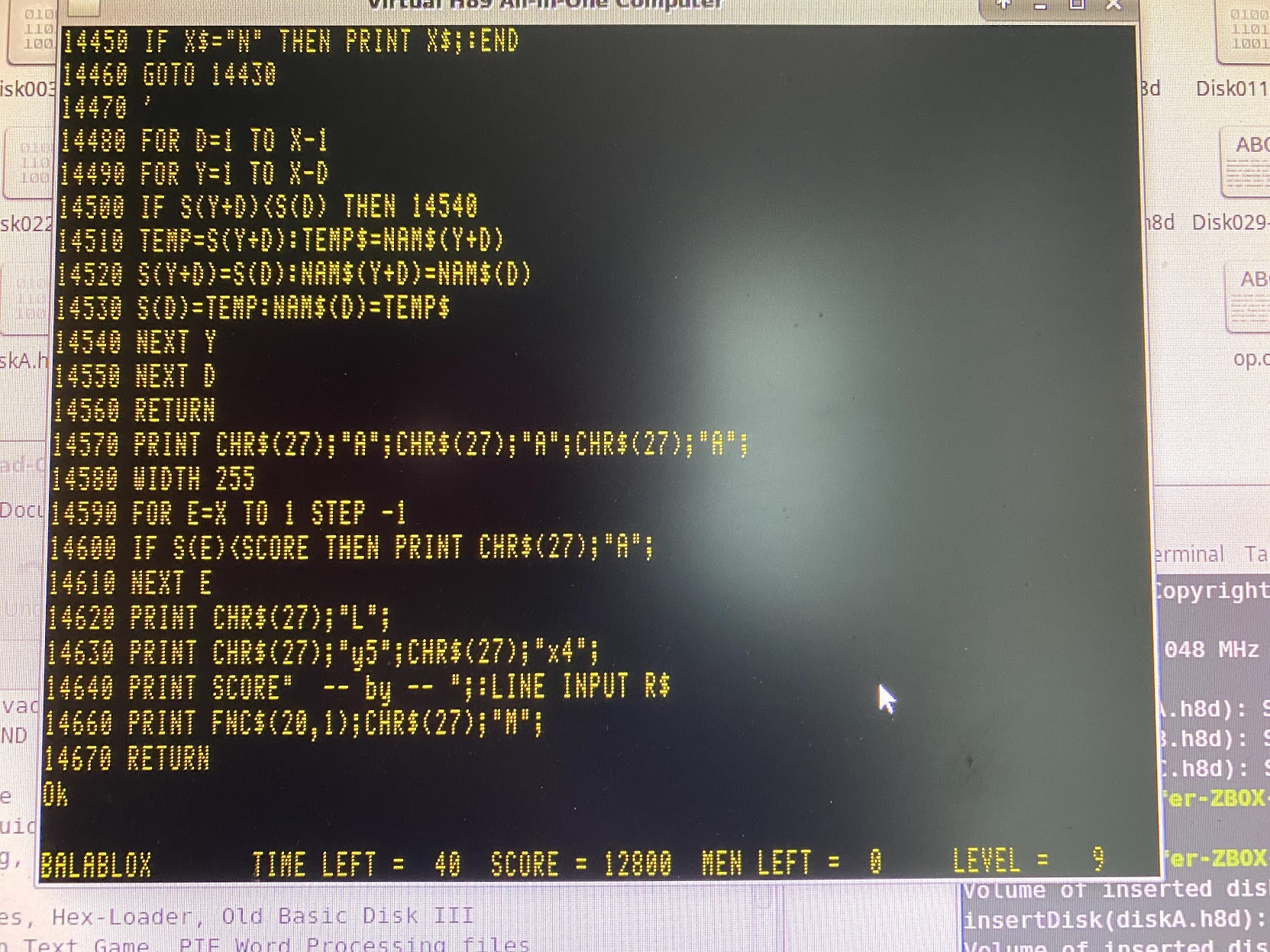
Apparently I started on a sequel, SUPER BALABLOX...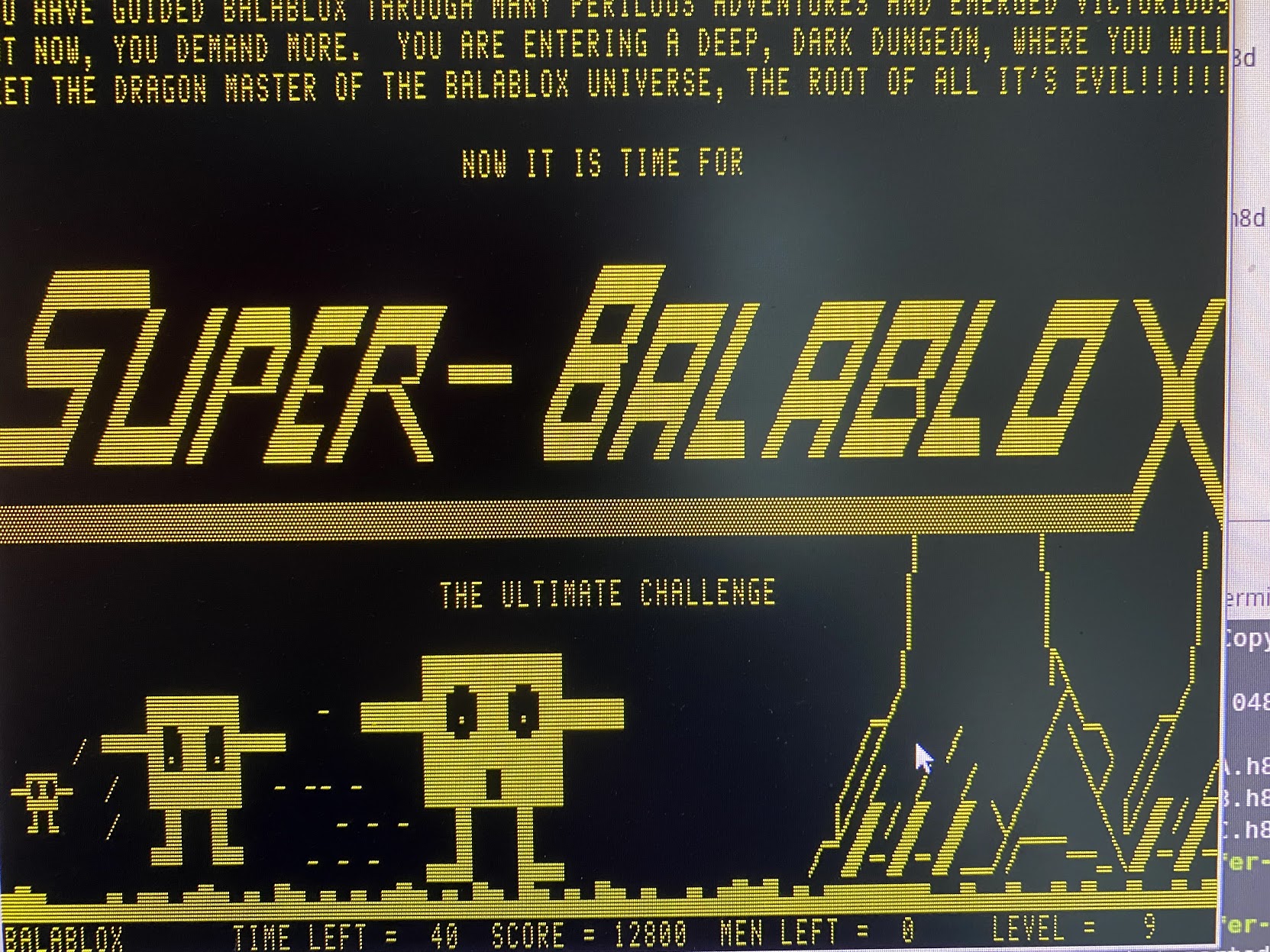
It starts off with you falling in a deep pit, with all your old enemies dead and buried!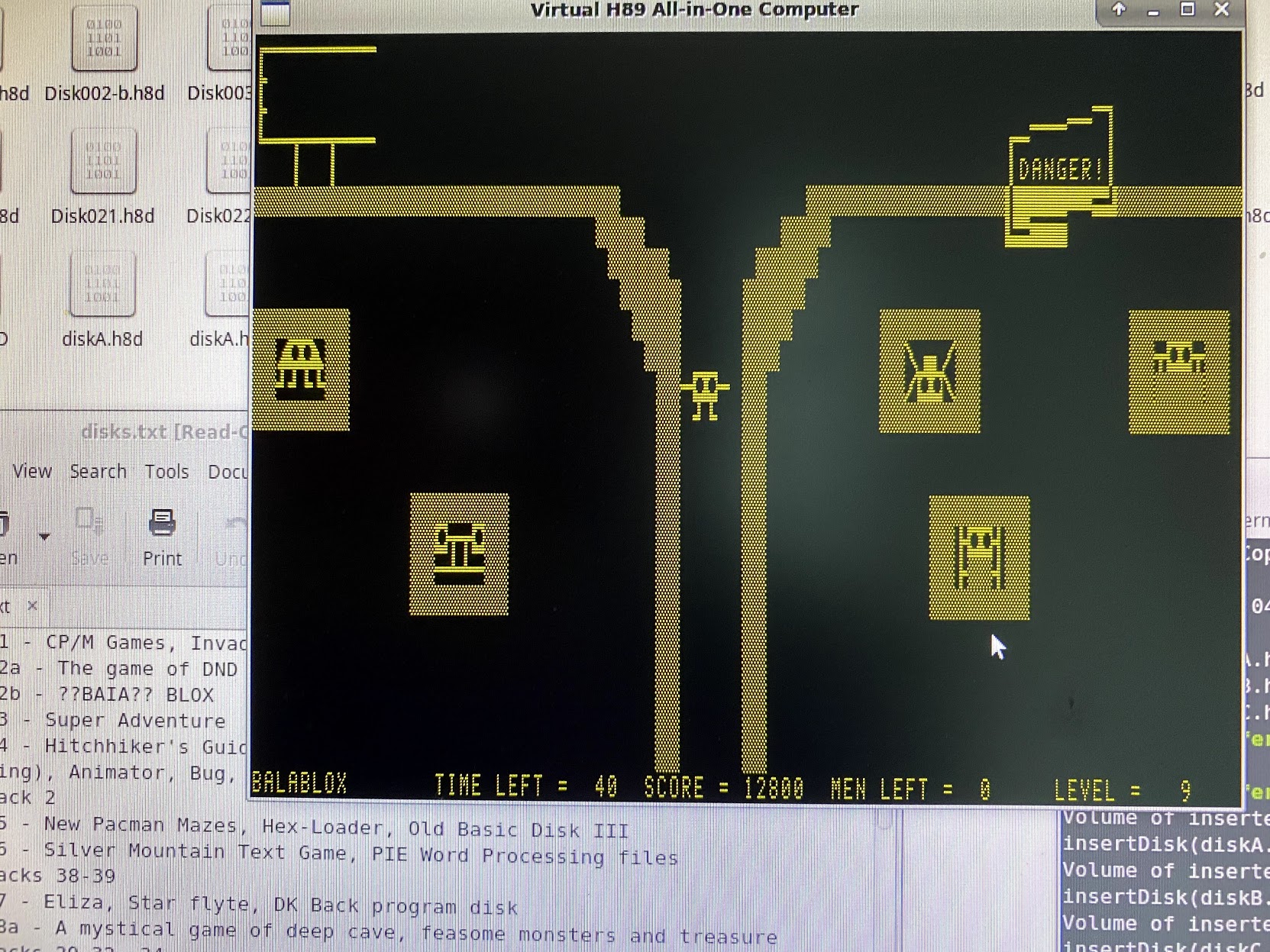
And you end up facing an incredibly powerful dragon! And then the game just... ends. I never got any further. Never did beat that dragon. I started a couple of games on my new Packard Bell PC XT and the skeleton of one on my 386 (it had VGA!) but I never finished another game.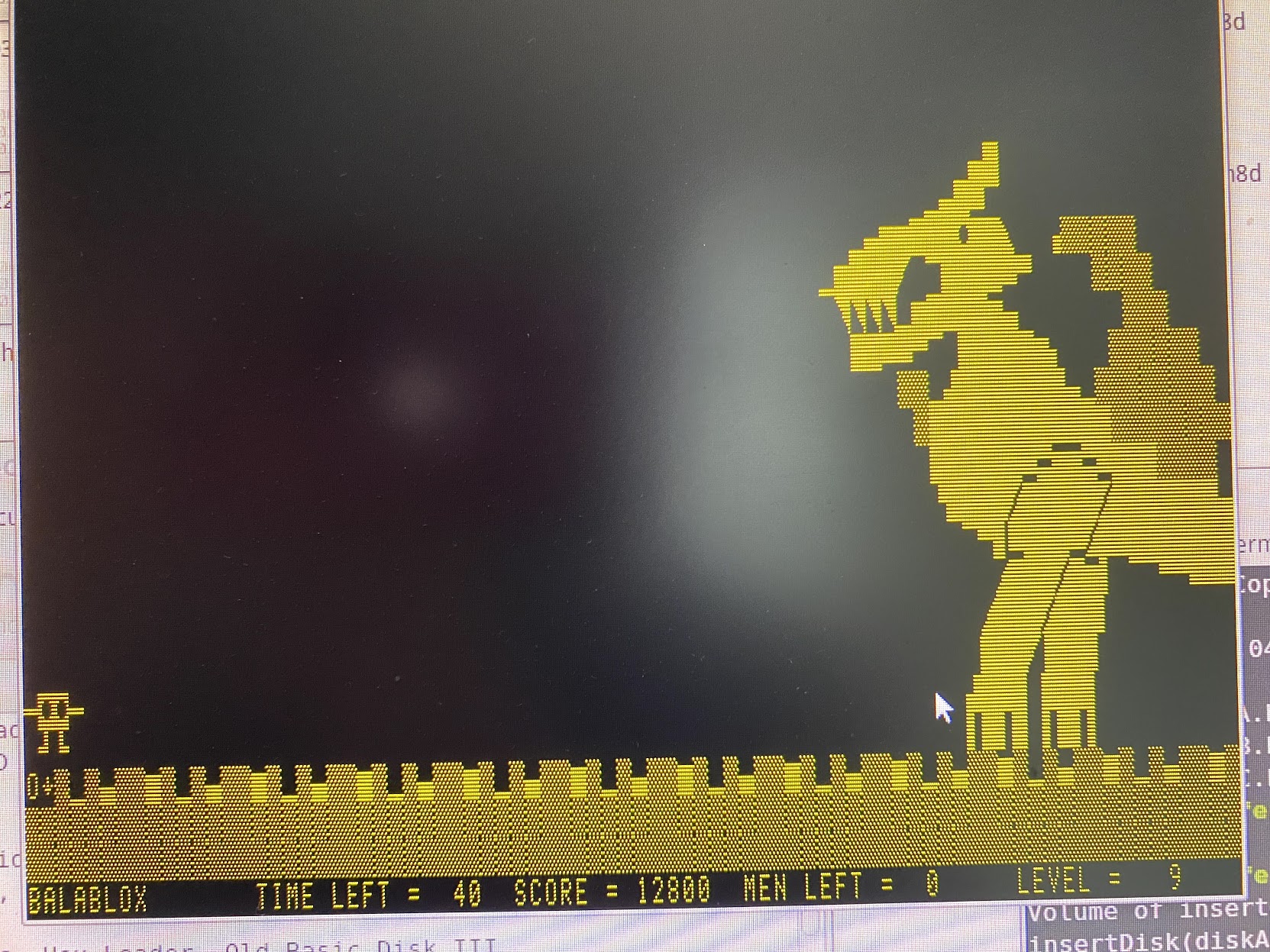
Life happened, things got busy, technology got more complicated. I was no longer between the ages of 7 and 15. Never would be again.
But you know what? Maybe I'll see if I can make a really simple fun game. Let's see what happens.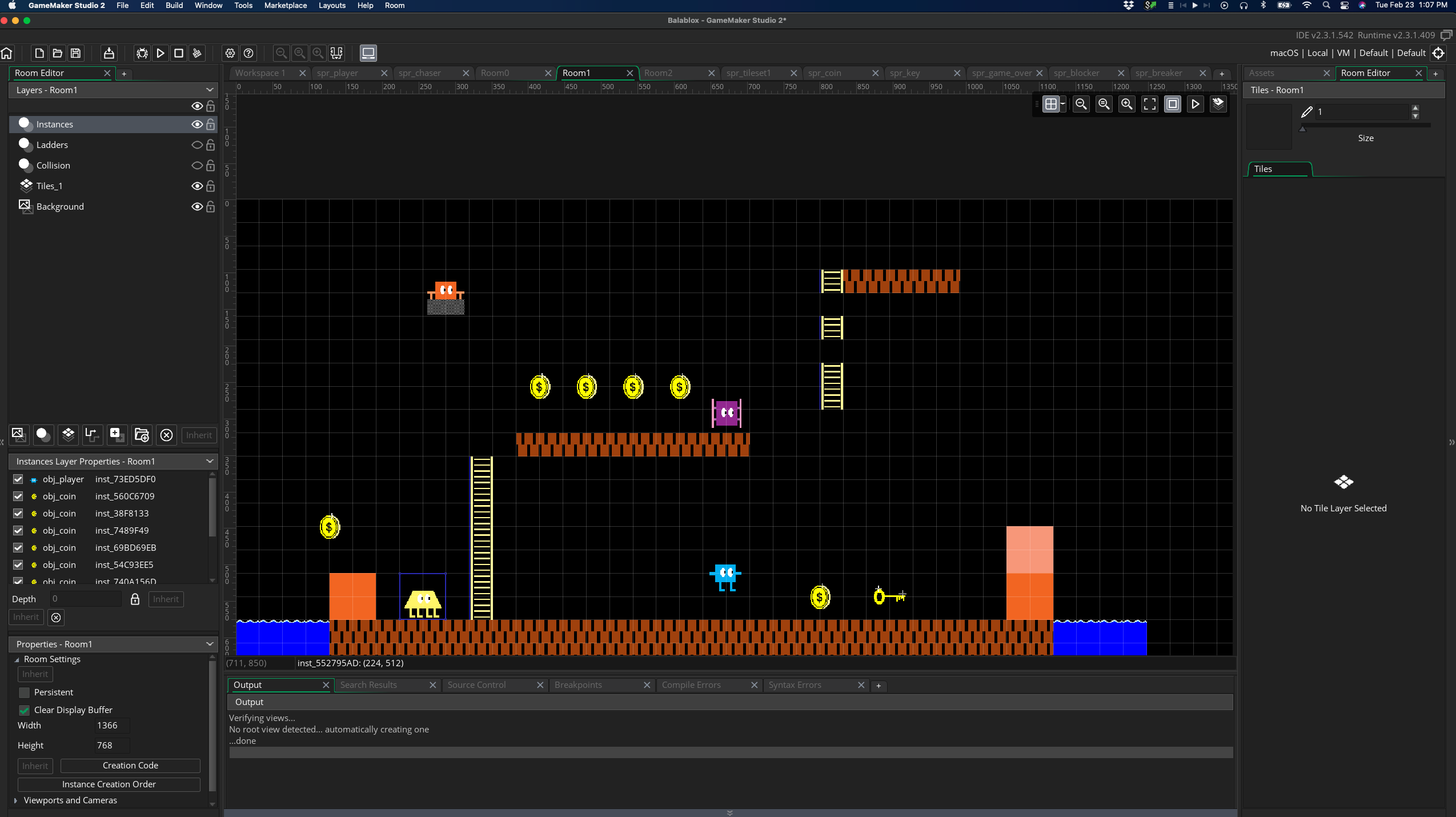
Note: huge thanks go out to Mark Garlanger for his Heathkit H-89 emulator, which you can find at https://heathkit.garlanger.com/emulator/ Without this emulator, I could never have revisited my childhood. I still have my original H-89, but it died in 1990 and the company died as well. Mark recovered 95% of my old floppies!
Views: 11784
Introducing Arcade Dreams
Post #: 281
Post type: Blog post
Date: 2020-10-23 18:53:21.000
Author: Jeremy Reimer
Tags: Gaming, Kickstarter
I've got an exciting announcement!
My friend Zach Weddington, who did the documentary Viva Amiga that I reviewed for Ars, just launched a Kickstarter for his next project. And I'm on the team! I've been hired as a writer for the project.
It's called Arcade Dreams, and it's a documentary series covering the history of arcade games, from the penny arcades of the 20s to the heydays of the 80s and 90s, right to the virtual reality rooms of today.
I'm really excited about this project, so please check out the link below. And if you Want to Know More(tm), read on...
https://www.kickstarter.com/projects/arcadedreams/Arcade-Dreams-The-Definitive-Arcade-Documentary-Series/
I remember the first time I walked into an arcade. It was like entering a dark cavern full of flickering neon lights and electronic sounds. It was intoxicating. The games drew me in, with their promise of an escape from a humdrum small town life into a universe full of possibilities. For a few, fleeting moments, and for just twenty-five cents, you could be anything.
Like me, director Zach Weddington had fond memories of arcades from his childhood. He went digging to find out more about their stories, and fell into a rabbit hole. It turned out that arcades were more than just a fad that came and went in the 1980s. They had actually been around for more than a century. Weddington, who was coming off the success of the documentary Viva Amiga, realized that if he wanted to see a comprehensive history of arcades, he would have to make it himself. “Growing up in the ’80s, like so many other kids, I was obsessed with arcades,” he said. “Now I get to turn this lifelong passion into my dream documentary series.”
Months later, after hundreds of hours of work, and assembling a team of industry heavyweights to help him, Weddington was finally ready to share his dream with the world. The Kickstarter for Arcade Dreams is now live, and it looks fantastic.
Arcade Dreams is a multi-part documentary about the 100-year history of arcades through the eyes of the game designers, the players, and the games themselves. Starting with the “penny arcade” mechanical amusements in the early 20th century, these games slowly gained in sophistication. Electrical augmentations added sounds, skill challenges, and scoring. Then, in the 1970s, a new invention called the microprocessor revolutionized the industry. Arcade games became video games, but many of the early titles were an evolution from their electro-mechanical ancestors. One example:Sega’s Gun Fight, a confrontation between two small cowboy figurines in a Wild West diorama, inspired Taito’s Gun Fight, an early video game.
Arcades peaked in popularity in the 1980s, then started to decline. In the 1990s, as home gaming consoles started to replace arcades in children’s imaginations, arcades evolved again, providing new experiences like Dance Dance Revolution that you couldn’t get at home.
And even after pundits pronounced arcades dead, they carried on in places like Japan, just as popular as they had always been. In the 21st century, new amusement centers around the world experimented with the arcade formula. At the same time, retro arcades with 80s and 90s titles started to cash in on nostalgia, like the Guinness record-holding Galloping Ghost, which boasts more than 300 games. Collectors and fans bought and restored cabinets and created their own arcades in their garages and basements. People yearned for the social and community aspect of playing games in the same physical space. Even in 2020, with the pandemic keeping many of us at home, arcade owners are hanging on and planning for the future. Their stories, and others, are all part of Arcade Dreams.
Weddington has assembled some incredible talent to help him bring his vision to life. He joined up with Bill Winters, an Emmy award-winning Director of Photography (Jeffrey Epstein: Filthy Rich, Comedians in Cars Getting Coffee), and legendary producer John Fahy, who has worked with Martin Scorsese, Quentin Tarantino, and Peter Jackson. Executive producer Berge Garabedian, who runs the popular movie review website JoBlo.com, came on board after a chance encounter in an online pinball forum. “What drew me in was the film’s teaser trailer, I was like ‘Oh…my…God! This is my life!’ and I immediately wanted to be a part of the production team. It also feels like now is the perfect time for this project, as retro gaming and nostalgia from the 80s are uber-hot,” said Garabedian.
And Weddington also asked a certain long-time Ars Technica scribe to join the Arcade Dreams team as a writer. Yes, I’m proud to say that I’m part of this project, and I’m both honored and humbled to be in such distinguished company. The footage that I’ve already viewed is incredible, and I can’t wait to see it all come together.
What really makes this series stand out is not just the fancy 3D rendered titles, or even the gorgeous shots of the video games and pinball tables. It’s the people that Weddington found to tell their stories. I’ve been going through some of the interviewees and writing up their biographies, and there are some amazing characters. For example, Eugene Jarvis, who designed arcade classics such as Defender, Robotron: 2084, Cruis’n USA, Pinbot, NARC, and Smash TV. There’s George McAuliffe, who was a sales manager for Time-Out Amusement Centers right when the arcades started to collapse, and worked with Dave Corriveau to help found Dave & Buster’s. And Roger Sharpe, who literally saved pinball in the 1970s, playing for the game’s life in a dramatic courtroom battle to prove that winning was due to skill, not chance.
Joining these industry legends are a host of designers, fans, collectors, restorers, and arcade operators, too many to list here. Together, they combine to tell a story that is more than just about games. It’s about art, technology, and passion all combining to create windows into other worlds, and to bring imagination and fun to life. It’s about bringing people together to test their mettle against the machines and against each other. Ultimately, it’s about us, and how our dreams became reflected against the plexiglass in a darkened room.
The Arcade Dreams Kickstarter is now live. It will run out of quarters in 45 days, so don’t forget to insert your coin.
Views: 4010
So who am I?
I'm a writer and programmer. I write science fiction stories and novels.
I am the writer for the upcoming documentary series Arcade Dreams.
I also write technology articles for Ars Technica.
I'm the creator of newLISP on Rockets, a web development framework and blog application.
- Email: jeremy.reimer@gmail.com
Topics
3D Modeling
About Me
Amiga
Articles
Audio
Blockchain
Blog
Blogs
Book Reviews
Book review
Comics
Computer history
Computers
Computers Microhistory
Computing
Conventions
Crypto
Daily update
Entrepreneur
Family
Forum post
Gaming
Gaming Starcraft
Gaming metaverse
Internet
Jeremy Birthday
Keats
Kickstarter
Knotty Geeks
Knotty Geeks (video)
Market Share
Masters Trilogy
Monarch
Movies
My Non-Fiction
My Science Fiction
NewLISP Blog
Novels
OSY
Operating Systems
Pets
Poll
Reviews
Science Fiction
Servers
Software
Software Operating Systems
Space
Star Gamer
Star Trek
Starcraft
Television
Testing
Toys Childhood
Valheim
Wedding Marriage
Work
Work Life
World
Writing
 RSS Feed for this blog
RSS Feed for this blog